Effect of Audit Reports on Annual Financial Reporting Quality of an Organisation
VerifiedAdded on 2023/06/12
|28
|7946
|372
AI Summary
This research examines the influence of audit quality on financial reporting in Australia. It includes a literature review on measures of financial reporting quality, components of quality, and the influence of auditing on financial reporting. The study aims to augment quality of audit and overall reliability of financial reporting.
Contribute Materials
Your contribution can guide someone’s learning journey. Share your
documents today.
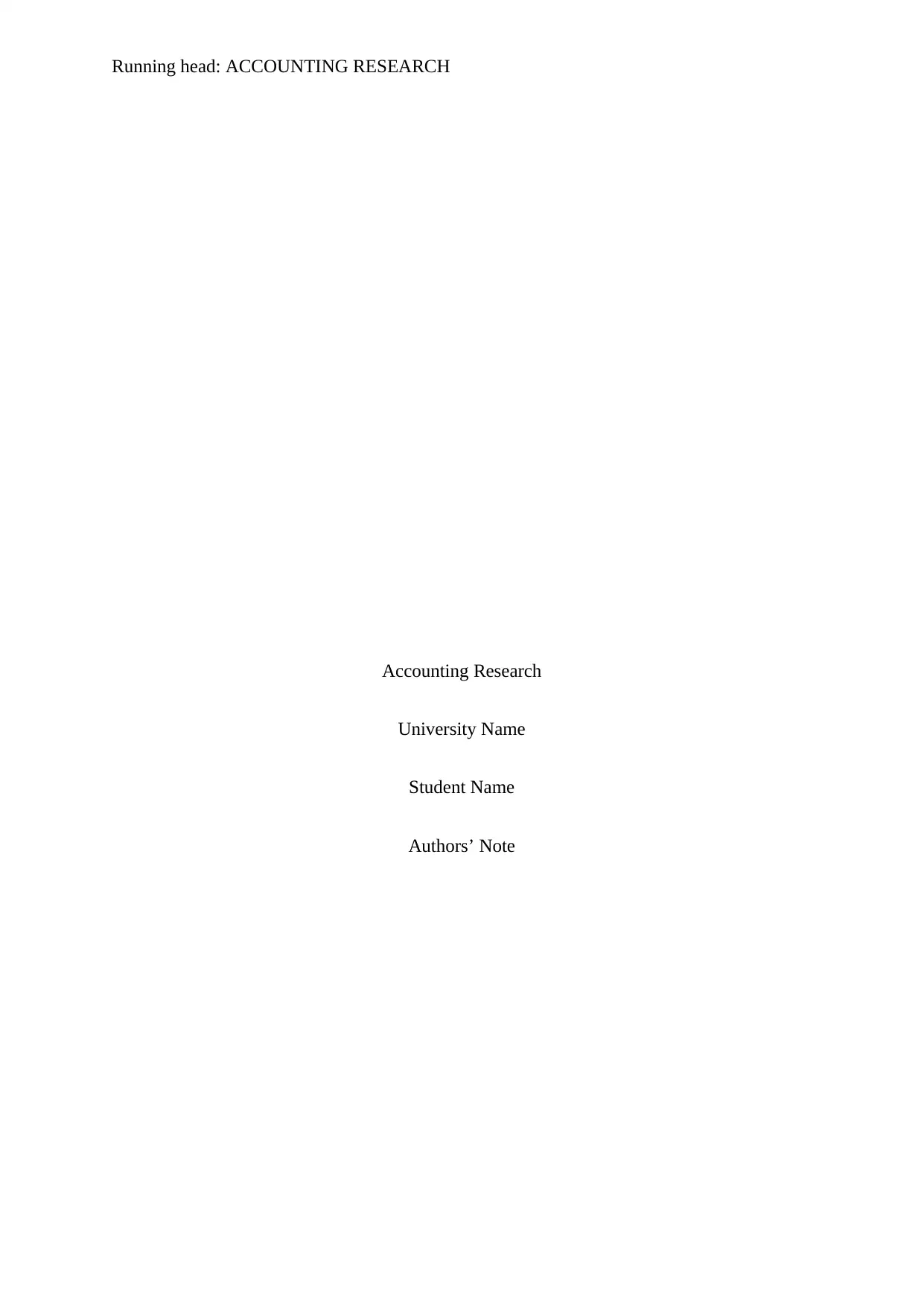
Running head: ACCOUNTING RESEARCH
Accounting Research
University Name
Student Name
Authors’ Note
Accounting Research
University Name
Student Name
Authors’ Note
Secure Best Marks with AI Grader
Need help grading? Try our AI Grader for instant feedback on your assignments.
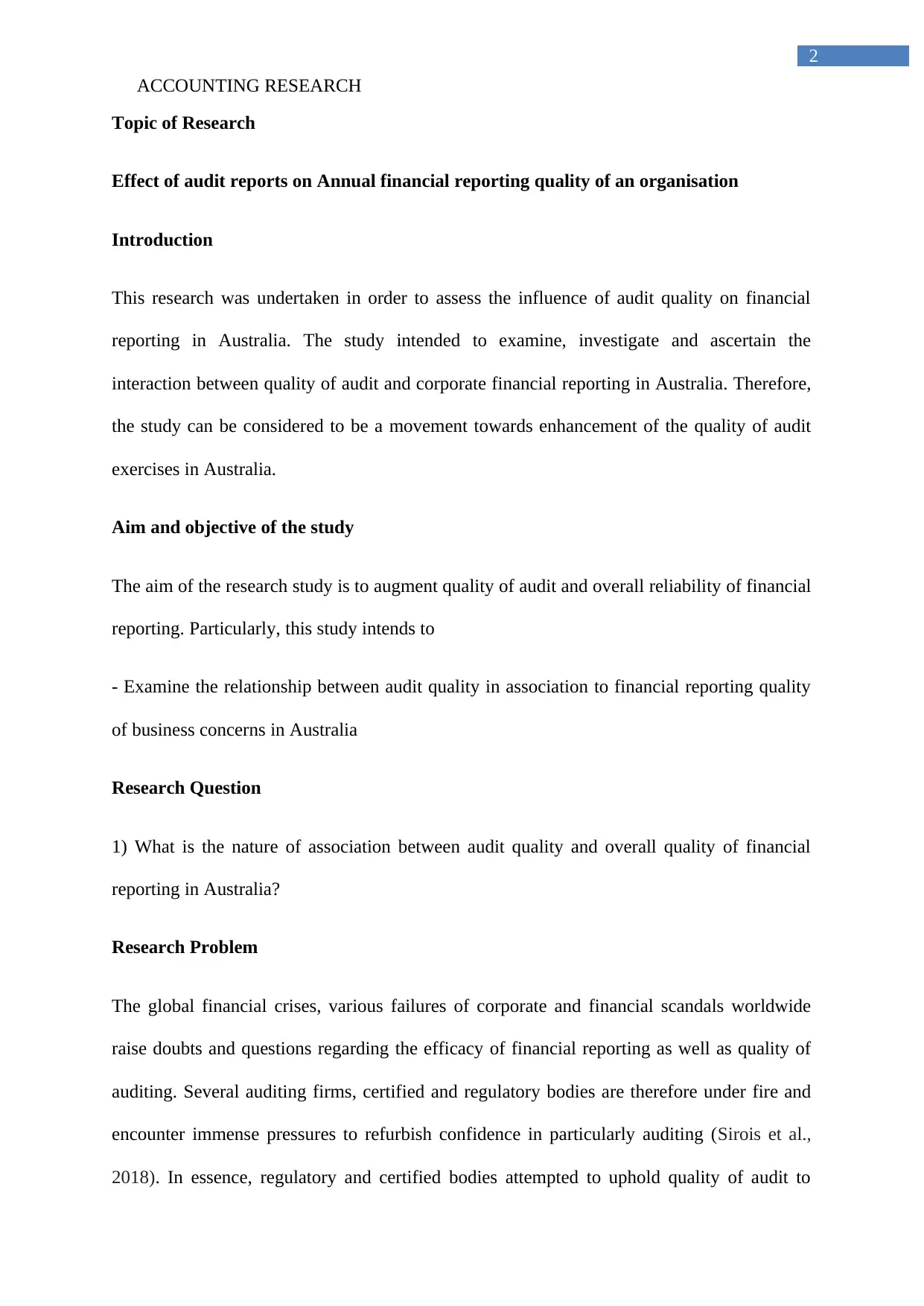
2
ACCOUNTING RESEARCH
Topic of Research
Effect of audit reports on Annual financial reporting quality of an organisation
Introduction
This research was undertaken in order to assess the influence of audit quality on financial
reporting in Australia. The study intended to examine, investigate and ascertain the
interaction between quality of audit and corporate financial reporting in Australia. Therefore,
the study can be considered to be a movement towards enhancement of the quality of audit
exercises in Australia.
Aim and objective of the study
The aim of the research study is to augment quality of audit and overall reliability of financial
reporting. Particularly, this study intends to
- Examine the relationship between audit quality in association to financial reporting quality
of business concerns in Australia
Research Question
1) What is the nature of association between audit quality and overall quality of financial
reporting in Australia?
Research Problem
The global financial crises, various failures of corporate and financial scandals worldwide
raise doubts and questions regarding the efficacy of financial reporting as well as quality of
auditing. Several auditing firms, certified and regulatory bodies are therefore under fire and
encounter immense pressures to refurbish confidence in particularly auditing (Sirois et al.,
2018). In essence, regulatory and certified bodies attempted to uphold quality of audit to
ACCOUNTING RESEARCH
Topic of Research
Effect of audit reports on Annual financial reporting quality of an organisation
Introduction
This research was undertaken in order to assess the influence of audit quality on financial
reporting in Australia. The study intended to examine, investigate and ascertain the
interaction between quality of audit and corporate financial reporting in Australia. Therefore,
the study can be considered to be a movement towards enhancement of the quality of audit
exercises in Australia.
Aim and objective of the study
The aim of the research study is to augment quality of audit and overall reliability of financial
reporting. Particularly, this study intends to
- Examine the relationship between audit quality in association to financial reporting quality
of business concerns in Australia
Research Question
1) What is the nature of association between audit quality and overall quality of financial
reporting in Australia?
Research Problem
The global financial crises, various failures of corporate and financial scandals worldwide
raise doubts and questions regarding the efficacy of financial reporting as well as quality of
auditing. Several auditing firms, certified and regulatory bodies are therefore under fire and
encounter immense pressures to refurbish confidence in particularly auditing (Sirois et al.,
2018). In essence, regulatory and certified bodies attempted to uphold quality of audit to
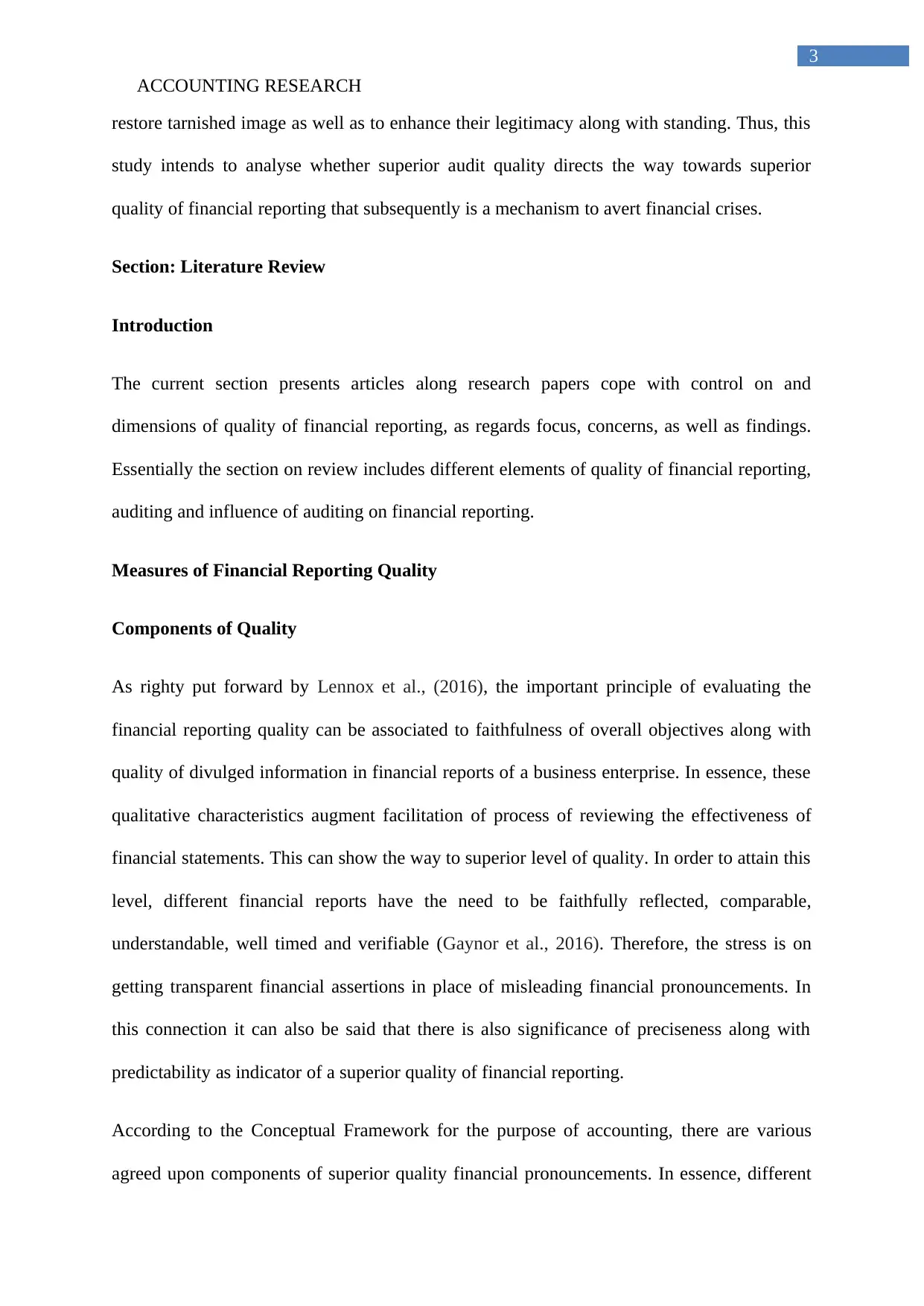
3
ACCOUNTING RESEARCH
restore tarnished image as well as to enhance their legitimacy along with standing. Thus, this
study intends to analyse whether superior audit quality directs the way towards superior
quality of financial reporting that subsequently is a mechanism to avert financial crises.
Section: Literature Review
Introduction
The current section presents articles along research papers cope with control on and
dimensions of quality of financial reporting, as regards focus, concerns, as well as findings.
Essentially the section on review includes different elements of quality of financial reporting,
auditing and influence of auditing on financial reporting.
Measures of Financial Reporting Quality
Components of Quality
As righty put forward by Lennox et al., (2016), the important principle of evaluating the
financial reporting quality can be associated to faithfulness of overall objectives along with
quality of divulged information in financial reports of a business enterprise. In essence, these
qualitative characteristics augment facilitation of process of reviewing the effectiveness of
financial statements. This can show the way to superior level of quality. In order to attain this
level, different financial reports have the need to be faithfully reflected, comparable,
understandable, well timed and verifiable (Gaynor et al., 2016). Therefore, the stress is on
getting transparent financial assertions in place of misleading financial pronouncements. In
this connection it can also be said that there is also significance of preciseness along with
predictability as indicator of a superior quality of financial reporting.
According to the Conceptual Framework for the purpose of accounting, there are various
agreed upon components of superior quality financial pronouncements. In essence, different
ACCOUNTING RESEARCH
restore tarnished image as well as to enhance their legitimacy along with standing. Thus, this
study intends to analyse whether superior audit quality directs the way towards superior
quality of financial reporting that subsequently is a mechanism to avert financial crises.
Section: Literature Review
Introduction
The current section presents articles along research papers cope with control on and
dimensions of quality of financial reporting, as regards focus, concerns, as well as findings.
Essentially the section on review includes different elements of quality of financial reporting,
auditing and influence of auditing on financial reporting.
Measures of Financial Reporting Quality
Components of Quality
As righty put forward by Lennox et al., (2016), the important principle of evaluating the
financial reporting quality can be associated to faithfulness of overall objectives along with
quality of divulged information in financial reports of a business enterprise. In essence, these
qualitative characteristics augment facilitation of process of reviewing the effectiveness of
financial statements. This can show the way to superior level of quality. In order to attain this
level, different financial reports have the need to be faithfully reflected, comparable,
understandable, well timed and verifiable (Gaynor et al., 2016). Therefore, the stress is on
getting transparent financial assertions in place of misleading financial pronouncements. In
this connection it can also be said that there is also significance of preciseness along with
predictability as indicator of a superior quality of financial reporting.
According to the Conceptual Framework for the purpose of accounting, there are various
agreed upon components of superior quality financial pronouncements. In essence, different
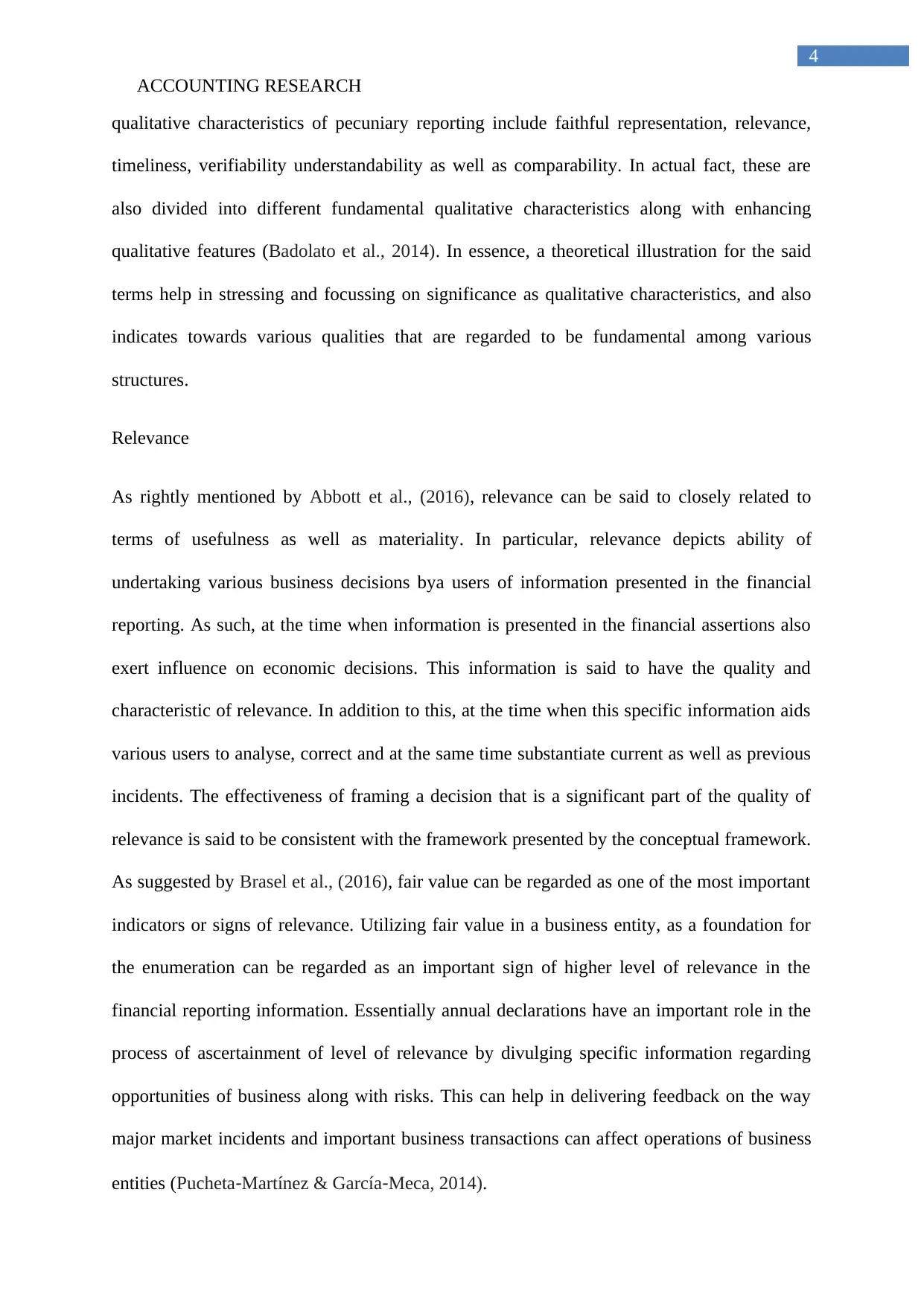
4
ACCOUNTING RESEARCH
qualitative characteristics of pecuniary reporting include faithful representation, relevance,
timeliness, verifiability understandability as well as comparability. In actual fact, these are
also divided into different fundamental qualitative characteristics along with enhancing
qualitative features (Badolato et al., 2014). In essence, a theoretical illustration for the said
terms help in stressing and focussing on significance as qualitative characteristics, and also
indicates towards various qualities that are regarded to be fundamental among various
structures.
Relevance
As rightly mentioned by Abbott et al., (2016), relevance can be said to closely related to
terms of usefulness as well as materiality. In particular, relevance depicts ability of
undertaking various business decisions bya users of information presented in the financial
reporting. As such, at the time when information is presented in the financial assertions also
exert influence on economic decisions. This information is said to have the quality and
characteristic of relevance. In addition to this, at the time when this specific information aids
various users to analyse, correct and at the same time substantiate current as well as previous
incidents. The effectiveness of framing a decision that is a significant part of the quality of
relevance is said to be consistent with the framework presented by the conceptual framework.
As suggested by Brasel et al., (2016), fair value can be regarded as one of the most important
indicators or signs of relevance. Utilizing fair value in a business entity, as a foundation for
the enumeration can be regarded as an important sign of higher level of relevance in the
financial reporting information. Essentially annual declarations have an important role in the
process of ascertainment of level of relevance by divulging specific information regarding
opportunities of business along with risks. This can help in delivering feedback on the way
major market incidents and important business transactions can affect operations of business
entities (Pucheta‐Martínez & García‐Meca, 2014).
ACCOUNTING RESEARCH
qualitative characteristics of pecuniary reporting include faithful representation, relevance,
timeliness, verifiability understandability as well as comparability. In actual fact, these are
also divided into different fundamental qualitative characteristics along with enhancing
qualitative features (Badolato et al., 2014). In essence, a theoretical illustration for the said
terms help in stressing and focussing on significance as qualitative characteristics, and also
indicates towards various qualities that are regarded to be fundamental among various
structures.
Relevance
As rightly mentioned by Abbott et al., (2016), relevance can be said to closely related to
terms of usefulness as well as materiality. In particular, relevance depicts ability of
undertaking various business decisions bya users of information presented in the financial
reporting. As such, at the time when information is presented in the financial assertions also
exert influence on economic decisions. This information is said to have the quality and
characteristic of relevance. In addition to this, at the time when this specific information aids
various users to analyse, correct and at the same time substantiate current as well as previous
incidents. The effectiveness of framing a decision that is a significant part of the quality of
relevance is said to be consistent with the framework presented by the conceptual framework.
As suggested by Brasel et al., (2016), fair value can be regarded as one of the most important
indicators or signs of relevance. Utilizing fair value in a business entity, as a foundation for
the enumeration can be regarded as an important sign of higher level of relevance in the
financial reporting information. Essentially annual declarations have an important role in the
process of ascertainment of level of relevance by divulging specific information regarding
opportunities of business along with risks. This can help in delivering feedback on the way
major market incidents and important business transactions can affect operations of business
entities (Pucheta‐Martínez & García‐Meca, 2014).
Secure Best Marks with AI Grader
Need help grading? Try our AI Grader for instant feedback on your assignments.
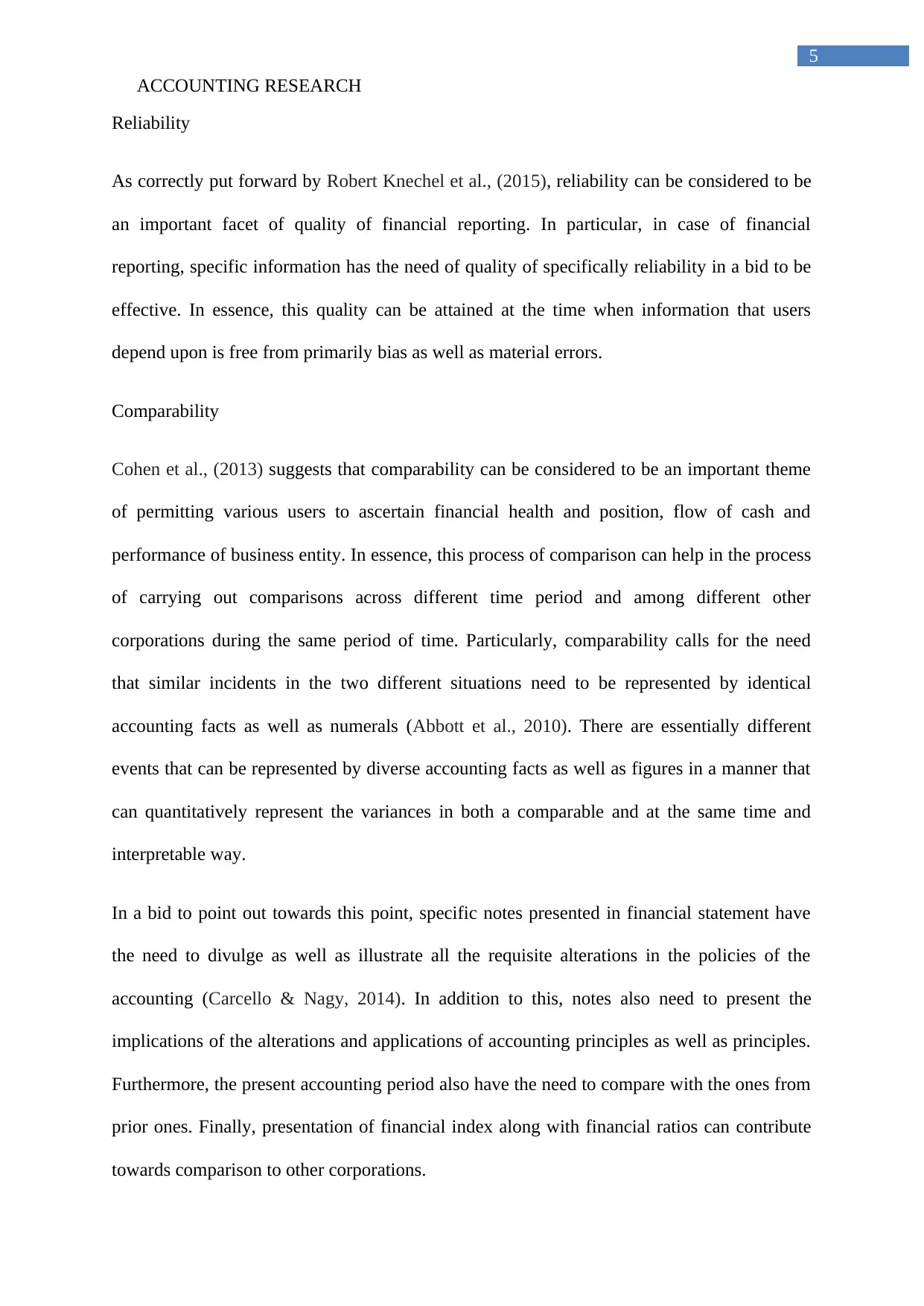
5
ACCOUNTING RESEARCH
Reliability
As correctly put forward by Robert Knechel et al., (2015), reliability can be considered to be
an important facet of quality of financial reporting. In particular, in case of financial
reporting, specific information has the need of quality of specifically reliability in a bid to be
effective. In essence, this quality can be attained at the time when information that users
depend upon is free from primarily bias as well as material errors.
Comparability
Cohen et al., (2013) suggests that comparability can be considered to be an important theme
of permitting various users to ascertain financial health and position, flow of cash and
performance of business entity. In essence, this process of comparison can help in the process
of carrying out comparisons across different time period and among different other
corporations during the same period of time. Particularly, comparability calls for the need
that similar incidents in the two different situations need to be represented by identical
accounting facts as well as numerals (Abbott et al., 2010). There are essentially different
events that can be represented by diverse accounting facts as well as figures in a manner that
can quantitatively represent the variances in both a comparable and at the same time and
interpretable way.
In a bid to point out towards this point, specific notes presented in financial statement have
the need to divulge as well as illustrate all the requisite alterations in the policies of the
accounting (Carcello & Nagy, 2014). In addition to this, notes also need to present the
implications of the alterations and applications of accounting principles as well as principles.
Furthermore, the present accounting period also have the need to compare with the ones from
prior ones. Finally, presentation of financial index along with financial ratios can contribute
towards comparison to other corporations.
ACCOUNTING RESEARCH
Reliability
As correctly put forward by Robert Knechel et al., (2015), reliability can be considered to be
an important facet of quality of financial reporting. In particular, in case of financial
reporting, specific information has the need of quality of specifically reliability in a bid to be
effective. In essence, this quality can be attained at the time when information that users
depend upon is free from primarily bias as well as material errors.
Comparability
Cohen et al., (2013) suggests that comparability can be considered to be an important theme
of permitting various users to ascertain financial health and position, flow of cash and
performance of business entity. In essence, this process of comparison can help in the process
of carrying out comparisons across different time period and among different other
corporations during the same period of time. Particularly, comparability calls for the need
that similar incidents in the two different situations need to be represented by identical
accounting facts as well as numerals (Abbott et al., 2010). There are essentially different
events that can be represented by diverse accounting facts as well as figures in a manner that
can quantitatively represent the variances in both a comparable and at the same time and
interpretable way.
In a bid to point out towards this point, specific notes presented in financial statement have
the need to divulge as well as illustrate all the requisite alterations in the policies of the
accounting (Carcello & Nagy, 2014). In addition to this, notes also need to present the
implications of the alterations and applications of accounting principles as well as principles.
Furthermore, the present accounting period also have the need to compare with the ones from
prior ones. Finally, presentation of financial index along with financial ratios can contribute
towards comparison to other corporations.
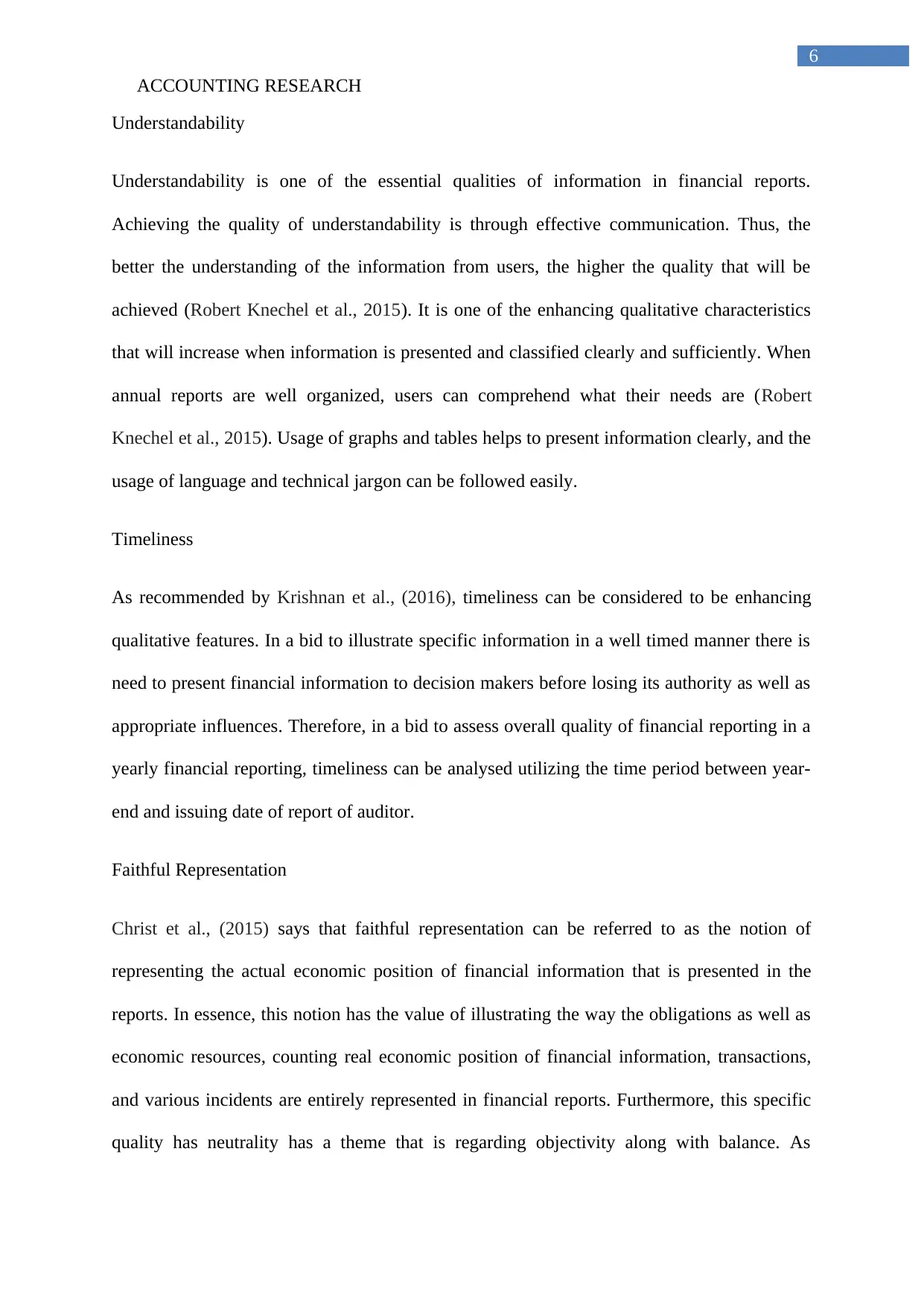
6
ACCOUNTING RESEARCH
Understandability
Understandability is one of the essential qualities of information in financial reports.
Achieving the quality of understandability is through effective communication. Thus, the
better the understanding of the information from users, the higher the quality that will be
achieved (Robert Knechel et al., 2015). It is one of the enhancing qualitative characteristics
that will increase when information is presented and classified clearly and sufficiently. When
annual reports are well organized, users can comprehend what their needs are (Robert
Knechel et al., 2015). Usage of graphs and tables helps to present information clearly, and the
usage of language and technical jargon can be followed easily.
Timeliness
As recommended by Krishnan et al., (2016), timeliness can be considered to be enhancing
qualitative features. In a bid to illustrate specific information in a well timed manner there is
need to present financial information to decision makers before losing its authority as well as
appropriate influences. Therefore, in a bid to assess overall quality of financial reporting in a
yearly financial reporting, timeliness can be analysed utilizing the time period between year-
end and issuing date of report of auditor.
Faithful Representation
Christ et al., (2015) says that faithful representation can be referred to as the notion of
representing the actual economic position of financial information that is presented in the
reports. In essence, this notion has the value of illustrating the way the obligations as well as
economic resources, counting real economic position of financial information, transactions,
and various incidents are entirely represented in financial reports. Furthermore, this specific
quality has neutrality has a theme that is regarding objectivity along with balance. As
ACCOUNTING RESEARCH
Understandability
Understandability is one of the essential qualities of information in financial reports.
Achieving the quality of understandability is through effective communication. Thus, the
better the understanding of the information from users, the higher the quality that will be
achieved (Robert Knechel et al., 2015). It is one of the enhancing qualitative characteristics
that will increase when information is presented and classified clearly and sufficiently. When
annual reports are well organized, users can comprehend what their needs are (Robert
Knechel et al., 2015). Usage of graphs and tables helps to present information clearly, and the
usage of language and technical jargon can be followed easily.
Timeliness
As recommended by Krishnan et al., (2016), timeliness can be considered to be enhancing
qualitative features. In a bid to illustrate specific information in a well timed manner there is
need to present financial information to decision makers before losing its authority as well as
appropriate influences. Therefore, in a bid to assess overall quality of financial reporting in a
yearly financial reporting, timeliness can be analysed utilizing the time period between year-
end and issuing date of report of auditor.
Faithful Representation
Christ et al., (2015) says that faithful representation can be referred to as the notion of
representing the actual economic position of financial information that is presented in the
reports. In essence, this notion has the value of illustrating the way the obligations as well as
economic resources, counting real economic position of financial information, transactions,
and various incidents are entirely represented in financial reports. Furthermore, this specific
quality has neutrality has a theme that is regarding objectivity along with balance. As
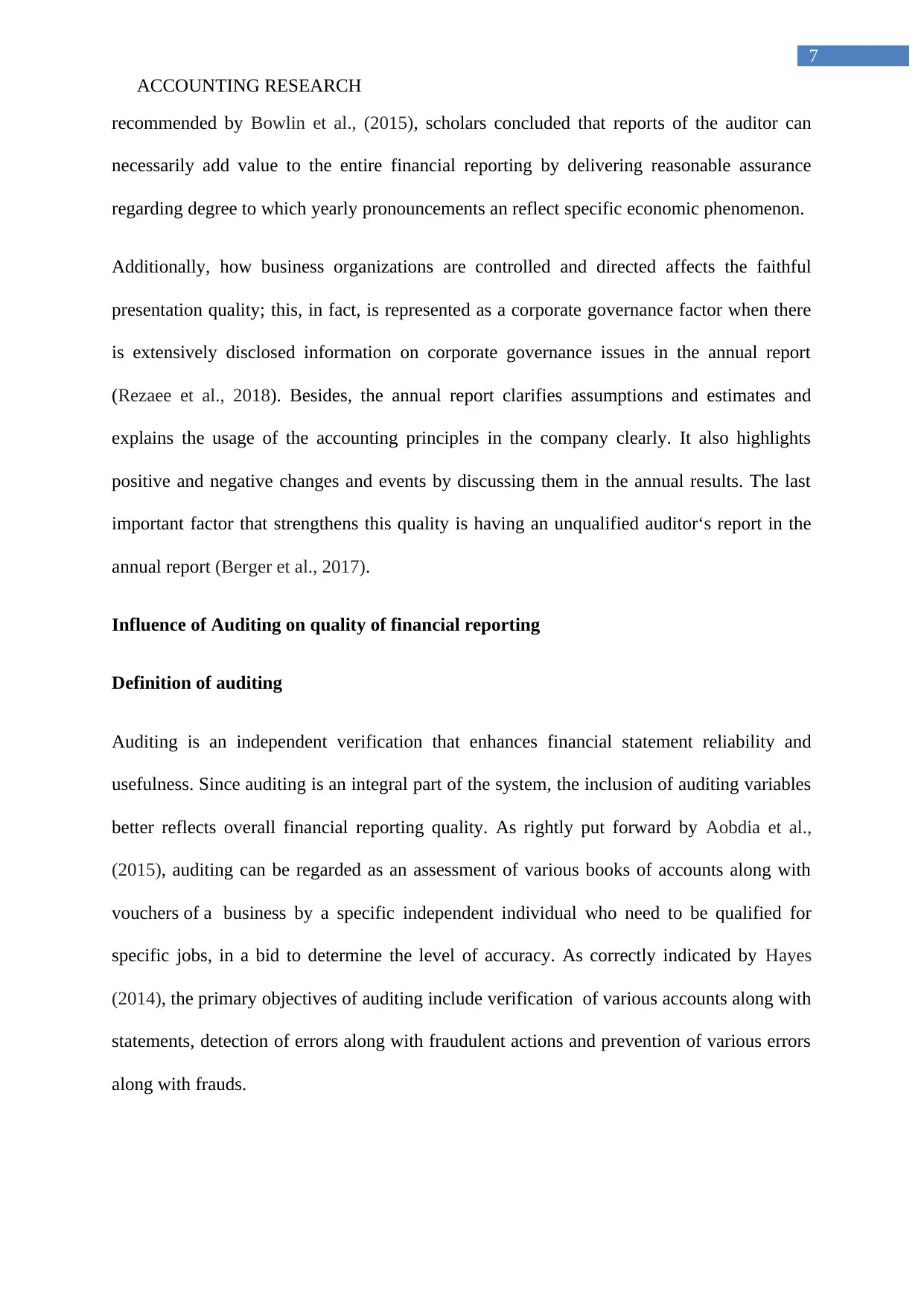
7
ACCOUNTING RESEARCH
recommended by Bowlin et al., (2015), scholars concluded that reports of the auditor can
necessarily add value to the entire financial reporting by delivering reasonable assurance
regarding degree to which yearly pronouncements an reflect specific economic phenomenon.
Additionally, how business organizations are controlled and directed affects the faithful
presentation quality; this, in fact, is represented as a corporate governance factor when there
is extensively disclosed information on corporate governance issues in the annual report
(Rezaee et al., 2018). Besides, the annual report clarifies assumptions and estimates and
explains the usage of the accounting principles in the company clearly. It also highlights
positive and negative changes and events by discussing them in the annual results. The last
important factor that strengthens this quality is having an unqualified auditor‘s report in the
annual report (Berger et al., 2017).
Influence of Auditing on quality of financial reporting
Definition of auditing
Auditing is an independent verification that enhances financial statement reliability and
usefulness. Since auditing is an integral part of the system, the inclusion of auditing variables
better reflects overall financial reporting quality. As rightly put forward by Aobdia et al.,
(2015), auditing can be regarded as an assessment of various books of accounts along with
vouchers of a business by a specific independent individual who need to be qualified for
specific jobs, in a bid to determine the level of accuracy. As correctly indicated by Hayes
(2014), the primary objectives of auditing include verification of various accounts along with
statements, detection of errors along with fraudulent actions and prevention of various errors
along with frauds.
ACCOUNTING RESEARCH
recommended by Bowlin et al., (2015), scholars concluded that reports of the auditor can
necessarily add value to the entire financial reporting by delivering reasonable assurance
regarding degree to which yearly pronouncements an reflect specific economic phenomenon.
Additionally, how business organizations are controlled and directed affects the faithful
presentation quality; this, in fact, is represented as a corporate governance factor when there
is extensively disclosed information on corporate governance issues in the annual report
(Rezaee et al., 2018). Besides, the annual report clarifies assumptions and estimates and
explains the usage of the accounting principles in the company clearly. It also highlights
positive and negative changes and events by discussing them in the annual results. The last
important factor that strengthens this quality is having an unqualified auditor‘s report in the
annual report (Berger et al., 2017).
Influence of Auditing on quality of financial reporting
Definition of auditing
Auditing is an independent verification that enhances financial statement reliability and
usefulness. Since auditing is an integral part of the system, the inclusion of auditing variables
better reflects overall financial reporting quality. As rightly put forward by Aobdia et al.,
(2015), auditing can be regarded as an assessment of various books of accounts along with
vouchers of a business by a specific independent individual who need to be qualified for
specific jobs, in a bid to determine the level of accuracy. As correctly indicated by Hayes
(2014), the primary objectives of auditing include verification of various accounts along with
statements, detection of errors along with fraudulent actions and prevention of various errors
along with frauds.
Paraphrase This Document
Need a fresh take? Get an instant paraphrase of this document with our AI Paraphraser
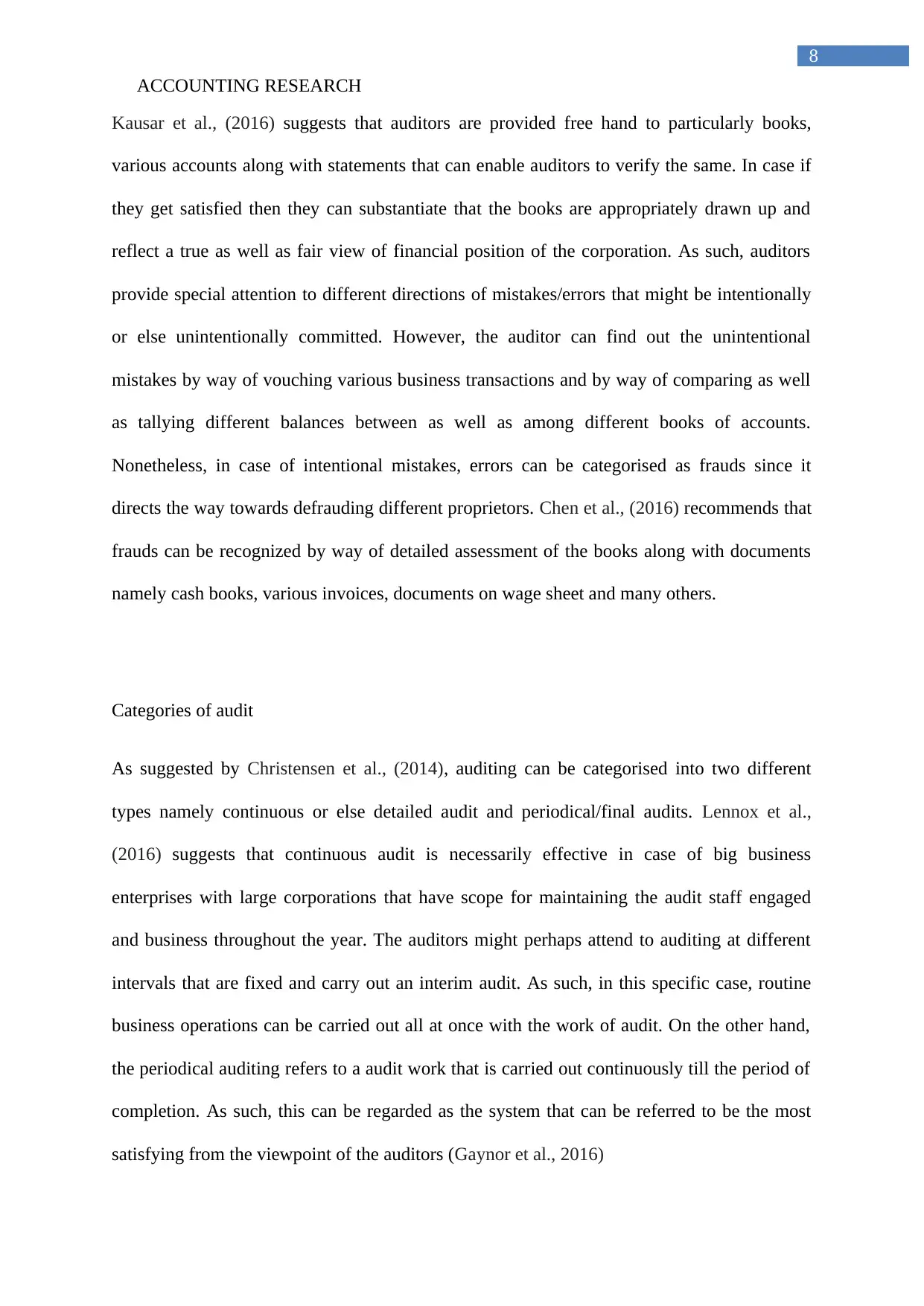
8
ACCOUNTING RESEARCH
Kausar et al., (2016) suggests that auditors are provided free hand to particularly books,
various accounts along with statements that can enable auditors to verify the same. In case if
they get satisfied then they can substantiate that the books are appropriately drawn up and
reflect a true as well as fair view of financial position of the corporation. As such, auditors
provide special attention to different directions of mistakes/errors that might be intentionally
or else unintentionally committed. However, the auditor can find out the unintentional
mistakes by way of vouching various business transactions and by way of comparing as well
as tallying different balances between as well as among different books of accounts.
Nonetheless, in case of intentional mistakes, errors can be categorised as frauds since it
directs the way towards defrauding different proprietors. Chen et al., (2016) recommends that
frauds can be recognized by way of detailed assessment of the books along with documents
namely cash books, various invoices, documents on wage sheet and many others.
Categories of audit
As suggested by Christensen et al., (2014), auditing can be categorised into two different
types namely continuous or else detailed audit and periodical/final audits. Lennox et al.,
(2016) suggests that continuous audit is necessarily effective in case of big business
enterprises with large corporations that have scope for maintaining the audit staff engaged
and business throughout the year. The auditors might perhaps attend to auditing at different
intervals that are fixed and carry out an interim audit. As such, in this specific case, routine
business operations can be carried out all at once with the work of audit. On the other hand,
the periodical auditing refers to a audit work that is carried out continuously till the period of
completion. As such, this can be regarded as the system that can be referred to be the most
satisfying from the viewpoint of the auditors (Gaynor et al., 2016)
ACCOUNTING RESEARCH
Kausar et al., (2016) suggests that auditors are provided free hand to particularly books,
various accounts along with statements that can enable auditors to verify the same. In case if
they get satisfied then they can substantiate that the books are appropriately drawn up and
reflect a true as well as fair view of financial position of the corporation. As such, auditors
provide special attention to different directions of mistakes/errors that might be intentionally
or else unintentionally committed. However, the auditor can find out the unintentional
mistakes by way of vouching various business transactions and by way of comparing as well
as tallying different balances between as well as among different books of accounts.
Nonetheless, in case of intentional mistakes, errors can be categorised as frauds since it
directs the way towards defrauding different proprietors. Chen et al., (2016) recommends that
frauds can be recognized by way of detailed assessment of the books along with documents
namely cash books, various invoices, documents on wage sheet and many others.
Categories of audit
As suggested by Christensen et al., (2014), auditing can be categorised into two different
types namely continuous or else detailed audit and periodical/final audits. Lennox et al.,
(2016) suggests that continuous audit is necessarily effective in case of big business
enterprises with large corporations that have scope for maintaining the audit staff engaged
and business throughout the year. The auditors might perhaps attend to auditing at different
intervals that are fixed and carry out an interim audit. As such, in this specific case, routine
business operations can be carried out all at once with the work of audit. On the other hand,
the periodical auditing refers to a audit work that is carried out continuously till the period of
completion. As such, this can be regarded as the system that can be referred to be the most
satisfying from the viewpoint of the auditors (Gaynor et al., 2016)

9
ACCOUNTING RESEARCH
Audit Processes for detection of fraud
Badolato et al., (2014) says that there are various processes of audit that can help in detection
of fraud. Whilst audits are not formulated to root out all the possibilities of fraudulent actions,
assessors have the accountability to recognize material misstatements in financial assertions
of business enterprises caused by fraudulent actions or else error. As suggested by Brasel et
al., (2016), audit engagements teams have the need to undertake brainstorming sessions at the
start of audit. Essentially, this session directed by the partner liable for audit, is formulated to
deliver time for the entire audit team to take into account the way business enterprises can
commit fraud. In addition to this, brainstorming meeting can be necessarily utilized to
establish a specific tone of professional scepticism in the process of audit. In particular, fraud
specialist also attend meetings to deliver deep insight into different forms of fraud committed
by various business enterprises and recognizes diverse risk factors of the client. Audit process
also helps in the process of testing of audit. Detection of fraud of material misstatement in
financial statements calls for the need of undertaking adjustments in financial records
(Pucheta‐Martínez & García‐Meca, 2014). In this case, assessors would test the journal
entries of the firm for any kind of adjustments and manipulations. In addition to this, in a bid
to carry out the test, after acquiring a clear understanding regarding the controls as well as
procedures of the business enterprise, the evaluator has the need to select from the journal
entries of the business concern. Furthermore, auditors also have the need to typically choose
different entries that are particularly large and designed by upper management of firm and
posted in particular accounting period. Once the process of selections has been carried out,
the evaluator can think about presenting supporting documentation that can substantiate each
and every entry.
As suggested by Cohen et al., (2013), another probable place for fraudulent actions is in the
estimates for accounting. As accounting estimates are necessarily subjective concepts,
ACCOUNTING RESEARCH
Audit Processes for detection of fraud
Badolato et al., (2014) says that there are various processes of audit that can help in detection
of fraud. Whilst audits are not formulated to root out all the possibilities of fraudulent actions,
assessors have the accountability to recognize material misstatements in financial assertions
of business enterprises caused by fraudulent actions or else error. As suggested by Brasel et
al., (2016), audit engagements teams have the need to undertake brainstorming sessions at the
start of audit. Essentially, this session directed by the partner liable for audit, is formulated to
deliver time for the entire audit team to take into account the way business enterprises can
commit fraud. In addition to this, brainstorming meeting can be necessarily utilized to
establish a specific tone of professional scepticism in the process of audit. In particular, fraud
specialist also attend meetings to deliver deep insight into different forms of fraud committed
by various business enterprises and recognizes diverse risk factors of the client. Audit process
also helps in the process of testing of audit. Detection of fraud of material misstatement in
financial statements calls for the need of undertaking adjustments in financial records
(Pucheta‐Martínez & García‐Meca, 2014). In this case, assessors would test the journal
entries of the firm for any kind of adjustments and manipulations. In addition to this, in a bid
to carry out the test, after acquiring a clear understanding regarding the controls as well as
procedures of the business enterprise, the evaluator has the need to select from the journal
entries of the business concern. Furthermore, auditors also have the need to typically choose
different entries that are particularly large and designed by upper management of firm and
posted in particular accounting period. Once the process of selections has been carried out,
the evaluator can think about presenting supporting documentation that can substantiate each
and every entry.
As suggested by Cohen et al., (2013), another probable place for fraudulent actions is in the
estimates for accounting. As accounting estimates are necessarily subjective concepts,
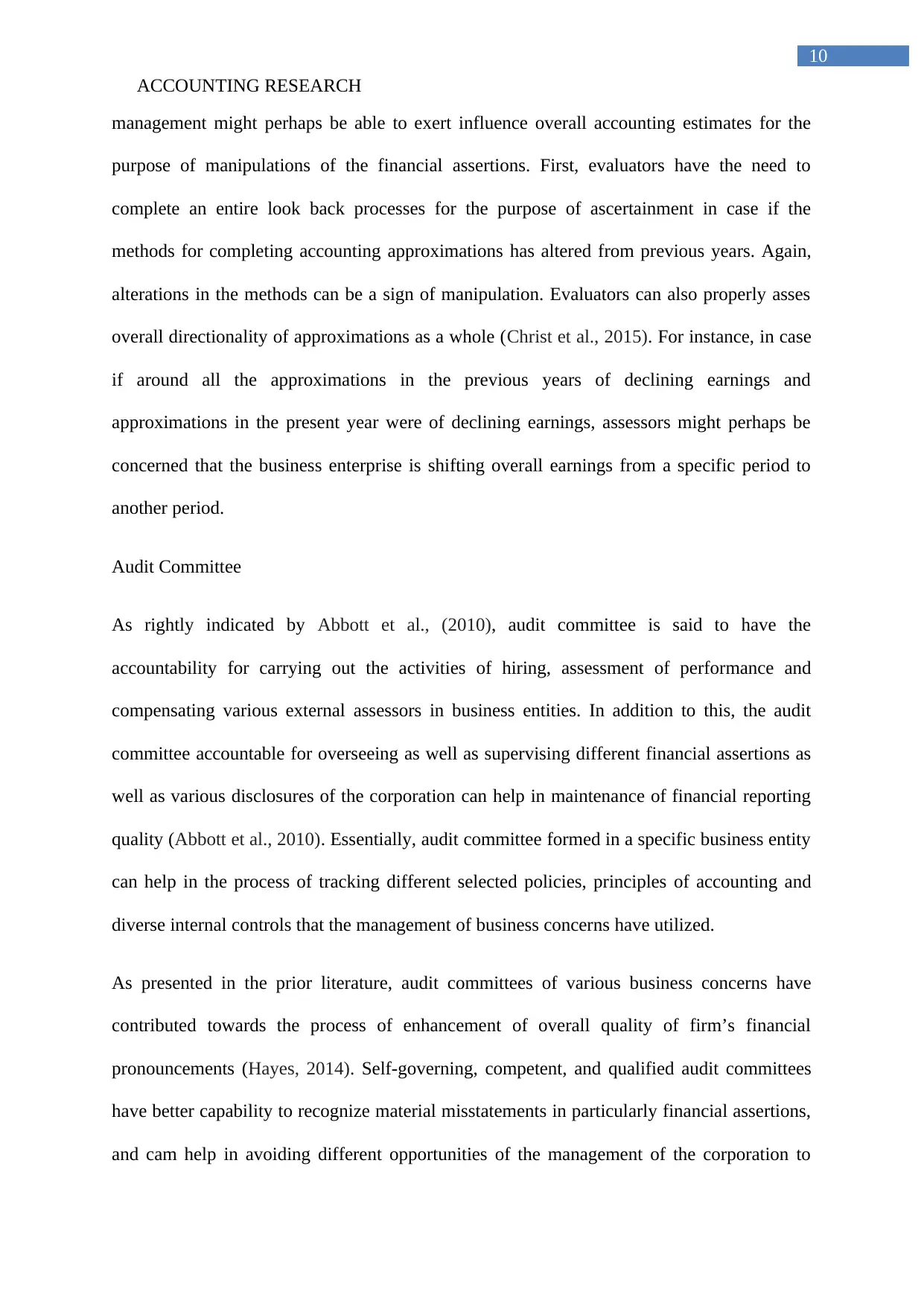
10
ACCOUNTING RESEARCH
management might perhaps be able to exert influence overall accounting estimates for the
purpose of manipulations of the financial assertions. First, evaluators have the need to
complete an entire look back processes for the purpose of ascertainment in case if the
methods for completing accounting approximations has altered from previous years. Again,
alterations in the methods can be a sign of manipulation. Evaluators can also properly asses
overall directionality of approximations as a whole (Christ et al., 2015). For instance, in case
if around all the approximations in the previous years of declining earnings and
approximations in the present year were of declining earnings, assessors might perhaps be
concerned that the business enterprise is shifting overall earnings from a specific period to
another period.
Audit Committee
As rightly indicated by Abbott et al., (2010), audit committee is said to have the
accountability for carrying out the activities of hiring, assessment of performance and
compensating various external assessors in business entities. In addition to this, the audit
committee accountable for overseeing as well as supervising different financial assertions as
well as various disclosures of the corporation can help in maintenance of financial reporting
quality (Abbott et al., 2010). Essentially, audit committee formed in a specific business entity
can help in the process of tracking different selected policies, principles of accounting and
diverse internal controls that the management of business concerns have utilized.
As presented in the prior literature, audit committees of various business concerns have
contributed towards the process of enhancement of overall quality of firm’s financial
pronouncements (Hayes, 2014). Self-governing, competent, and qualified audit committees
have better capability to recognize material misstatements in particularly financial assertions,
and cam help in avoiding different opportunities of the management of the corporation to
ACCOUNTING RESEARCH
management might perhaps be able to exert influence overall accounting estimates for the
purpose of manipulations of the financial assertions. First, evaluators have the need to
complete an entire look back processes for the purpose of ascertainment in case if the
methods for completing accounting approximations has altered from previous years. Again,
alterations in the methods can be a sign of manipulation. Evaluators can also properly asses
overall directionality of approximations as a whole (Christ et al., 2015). For instance, in case
if around all the approximations in the previous years of declining earnings and
approximations in the present year were of declining earnings, assessors might perhaps be
concerned that the business enterprise is shifting overall earnings from a specific period to
another period.
Audit Committee
As rightly indicated by Abbott et al., (2010), audit committee is said to have the
accountability for carrying out the activities of hiring, assessment of performance and
compensating various external assessors in business entities. In addition to this, the audit
committee accountable for overseeing as well as supervising different financial assertions as
well as various disclosures of the corporation can help in maintenance of financial reporting
quality (Abbott et al., 2010). Essentially, audit committee formed in a specific business entity
can help in the process of tracking different selected policies, principles of accounting and
diverse internal controls that the management of business concerns have utilized.
As presented in the prior literature, audit committees of various business concerns have
contributed towards the process of enhancement of overall quality of firm’s financial
pronouncements (Hayes, 2014). Self-governing, competent, and qualified audit committees
have better capability to recognize material misstatements in particularly financial assertions,
and cam help in avoiding different opportunities of the management of the corporation to
Secure Best Marks with AI Grader
Need help grading? Try our AI Grader for instant feedback on your assignments.
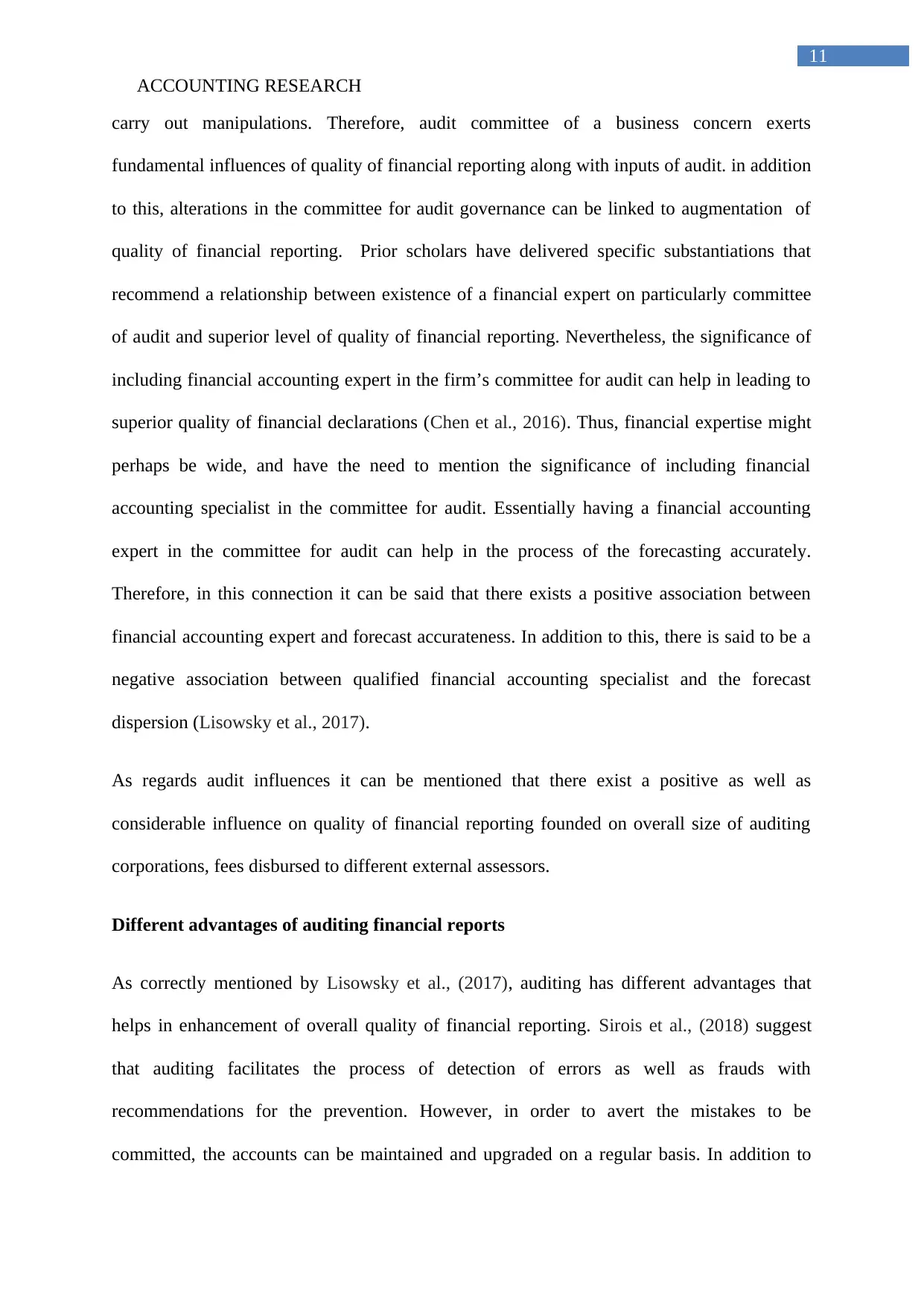
11
ACCOUNTING RESEARCH
carry out manipulations. Therefore, audit committee of a business concern exerts
fundamental influences of quality of financial reporting along with inputs of audit. in addition
to this, alterations in the committee for audit governance can be linked to augmentation of
quality of financial reporting. Prior scholars have delivered specific substantiations that
recommend a relationship between existence of a financial expert on particularly committee
of audit and superior level of quality of financial reporting. Nevertheless, the significance of
including financial accounting expert in the firm’s committee for audit can help in leading to
superior quality of financial declarations (Chen et al., 2016). Thus, financial expertise might
perhaps be wide, and have the need to mention the significance of including financial
accounting specialist in the committee for audit. Essentially having a financial accounting
expert in the committee for audit can help in the process of the forecasting accurately.
Therefore, in this connection it can be said that there exists a positive association between
financial accounting expert and forecast accurateness. In addition to this, there is said to be a
negative association between qualified financial accounting specialist and the forecast
dispersion (Lisowsky et al., 2017).
As regards audit influences it can be mentioned that there exist a positive as well as
considerable influence on quality of financial reporting founded on overall size of auditing
corporations, fees disbursed to different external assessors.
Different advantages of auditing financial reports
As correctly mentioned by Lisowsky et al., (2017), auditing has different advantages that
helps in enhancement of overall quality of financial reporting. Sirois et al., (2018) suggest
that auditing facilitates the process of detection of errors as well as frauds with
recommendations for the prevention. However, in order to avert the mistakes to be
committed, the accounts can be maintained and upgraded on a regular basis. In addition to
ACCOUNTING RESEARCH
carry out manipulations. Therefore, audit committee of a business concern exerts
fundamental influences of quality of financial reporting along with inputs of audit. in addition
to this, alterations in the committee for audit governance can be linked to augmentation of
quality of financial reporting. Prior scholars have delivered specific substantiations that
recommend a relationship between existence of a financial expert on particularly committee
of audit and superior level of quality of financial reporting. Nevertheless, the significance of
including financial accounting expert in the firm’s committee for audit can help in leading to
superior quality of financial declarations (Chen et al., 2016). Thus, financial expertise might
perhaps be wide, and have the need to mention the significance of including financial
accounting specialist in the committee for audit. Essentially having a financial accounting
expert in the committee for audit can help in the process of the forecasting accurately.
Therefore, in this connection it can be said that there exists a positive association between
financial accounting expert and forecast accurateness. In addition to this, there is said to be a
negative association between qualified financial accounting specialist and the forecast
dispersion (Lisowsky et al., 2017).
As regards audit influences it can be mentioned that there exist a positive as well as
considerable influence on quality of financial reporting founded on overall size of auditing
corporations, fees disbursed to different external assessors.
Different advantages of auditing financial reports
As correctly mentioned by Lisowsky et al., (2017), auditing has different advantages that
helps in enhancement of overall quality of financial reporting. Sirois et al., (2018) suggest
that auditing facilitates the process of detection of errors as well as frauds with
recommendations for the prevention. However, in order to avert the mistakes to be
committed, the accounts can be maintained and upgraded on a regular basis. In addition to
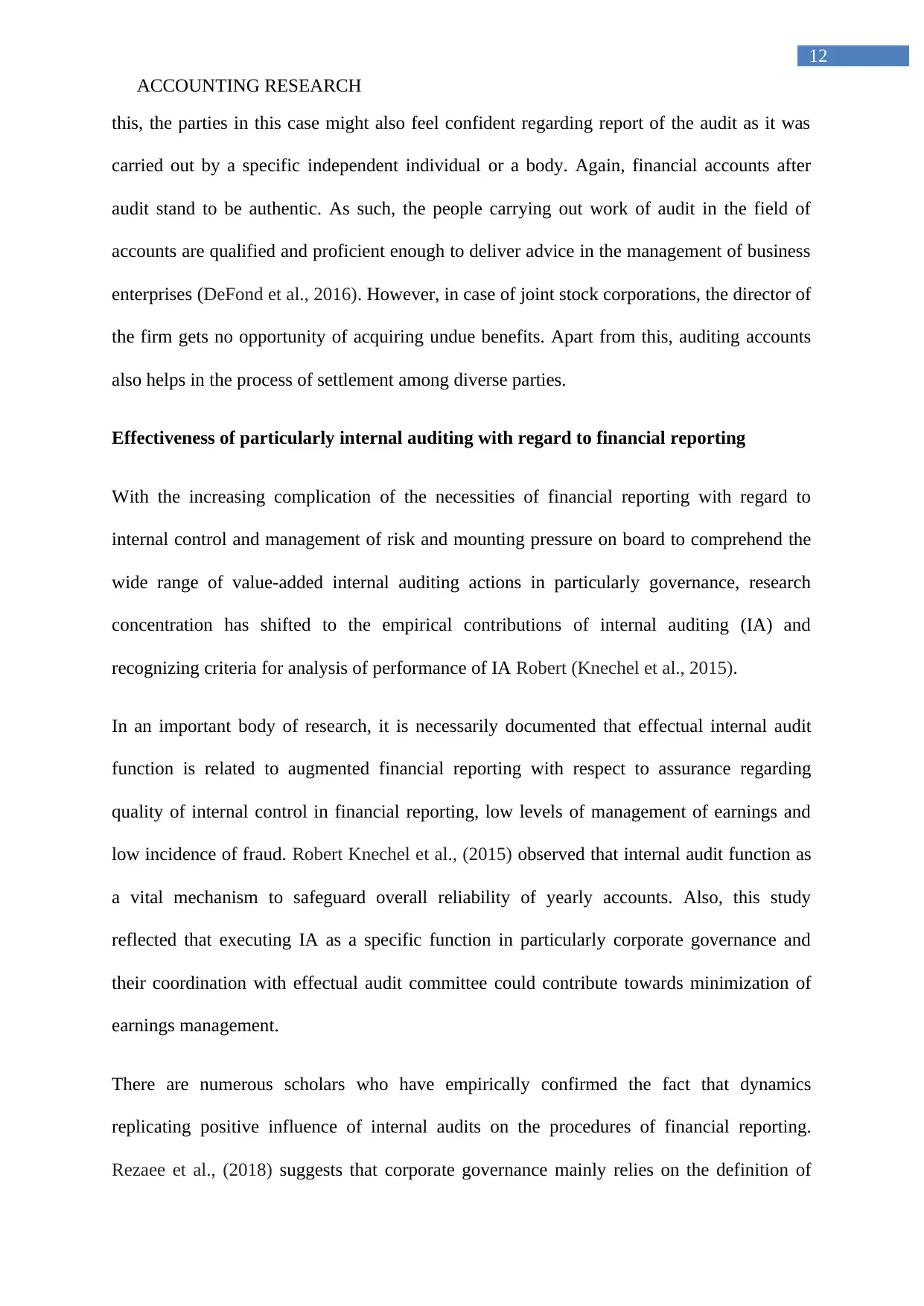
12
ACCOUNTING RESEARCH
this, the parties in this case might also feel confident regarding report of the audit as it was
carried out by a specific independent individual or a body. Again, financial accounts after
audit stand to be authentic. As such, the people carrying out work of audit in the field of
accounts are qualified and proficient enough to deliver advice in the management of business
enterprises (DeFond et al., 2016). However, in case of joint stock corporations, the director of
the firm gets no opportunity of acquiring undue benefits. Apart from this, auditing accounts
also helps in the process of settlement among diverse parties.
Effectiveness of particularly internal auditing with regard to financial reporting
With the increasing complication of the necessities of financial reporting with regard to
internal control and management of risk and mounting pressure on board to comprehend the
wide range of value-added internal auditing actions in particularly governance, research
concentration has shifted to the empirical contributions of internal auditing (IA) and
recognizing criteria for analysis of performance of IA Robert (Knechel et al., 2015).
In an important body of research, it is necessarily documented that effectual internal audit
function is related to augmented financial reporting with respect to assurance regarding
quality of internal control in financial reporting, low levels of management of earnings and
low incidence of fraud. Robert Knechel et al., (2015) observed that internal audit function as
a vital mechanism to safeguard overall reliability of yearly accounts. Also, this study
reflected that executing IA as a specific function in particularly corporate governance and
their coordination with effectual audit committee could contribute towards minimization of
earnings management.
There are numerous scholars who have empirically confirmed the fact that dynamics
replicating positive influence of internal audits on the procedures of financial reporting.
Rezaee et al., (2018) suggests that corporate governance mainly relies on the definition of
ACCOUNTING RESEARCH
this, the parties in this case might also feel confident regarding report of the audit as it was
carried out by a specific independent individual or a body. Again, financial accounts after
audit stand to be authentic. As such, the people carrying out work of audit in the field of
accounts are qualified and proficient enough to deliver advice in the management of business
enterprises (DeFond et al., 2016). However, in case of joint stock corporations, the director of
the firm gets no opportunity of acquiring undue benefits. Apart from this, auditing accounts
also helps in the process of settlement among diverse parties.
Effectiveness of particularly internal auditing with regard to financial reporting
With the increasing complication of the necessities of financial reporting with regard to
internal control and management of risk and mounting pressure on board to comprehend the
wide range of value-added internal auditing actions in particularly governance, research
concentration has shifted to the empirical contributions of internal auditing (IA) and
recognizing criteria for analysis of performance of IA Robert (Knechel et al., 2015).
In an important body of research, it is necessarily documented that effectual internal audit
function is related to augmented financial reporting with respect to assurance regarding
quality of internal control in financial reporting, low levels of management of earnings and
low incidence of fraud. Robert Knechel et al., (2015) observed that internal audit function as
a vital mechanism to safeguard overall reliability of yearly accounts. Also, this study
reflected that executing IA as a specific function in particularly corporate governance and
their coordination with effectual audit committee could contribute towards minimization of
earnings management.
There are numerous scholars who have empirically confirmed the fact that dynamics
replicating positive influence of internal audits on the procedures of financial reporting.
Rezaee et al., (2018) suggests that corporate governance mainly relies on the definition of
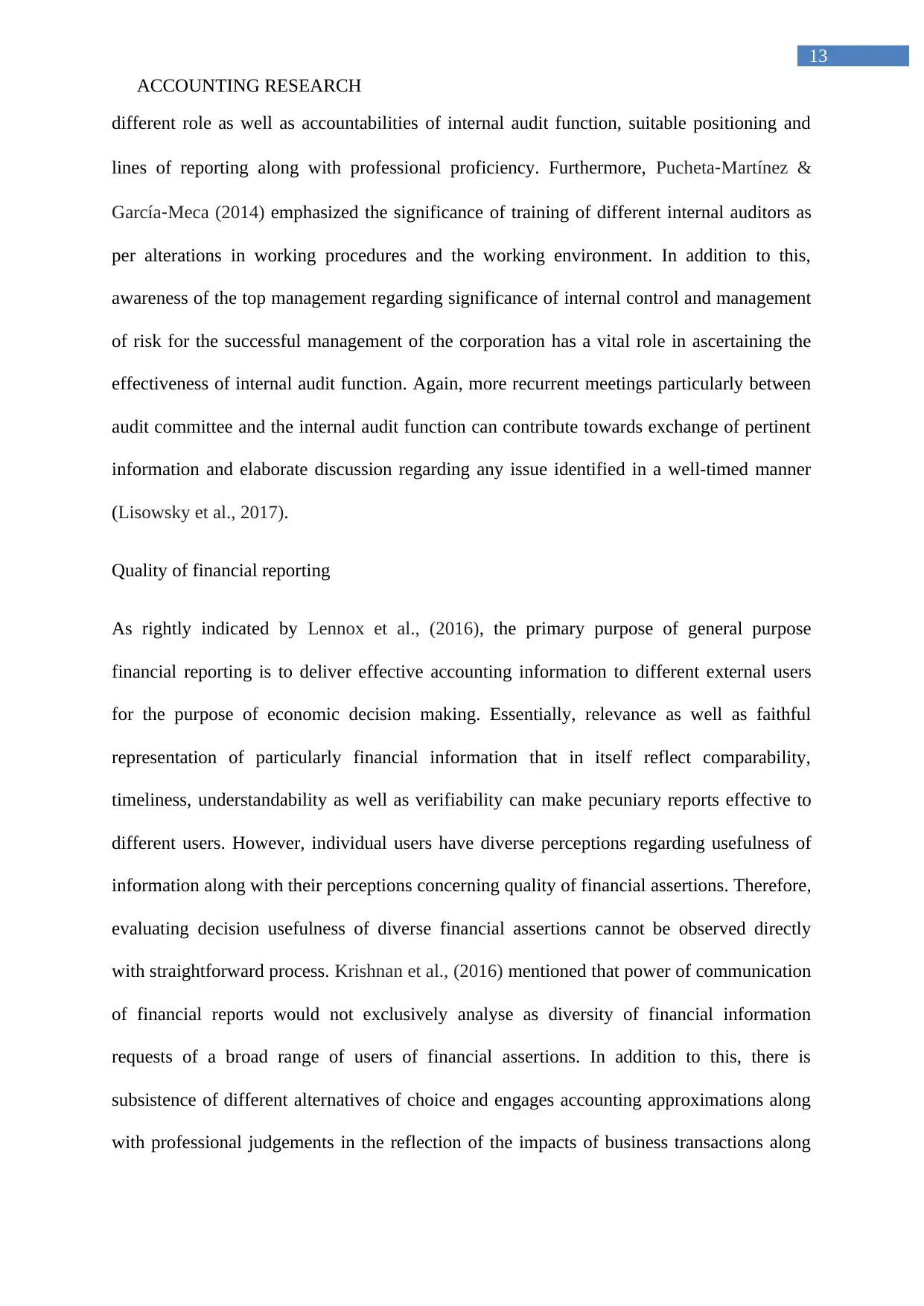
13
ACCOUNTING RESEARCH
different role as well as accountabilities of internal audit function, suitable positioning and
lines of reporting along with professional proficiency. Furthermore, Pucheta‐Martínez &
García‐Meca (2014) emphasized the significance of training of different internal auditors as
per alterations in working procedures and the working environment. In addition to this,
awareness of the top management regarding significance of internal control and management
of risk for the successful management of the corporation has a vital role in ascertaining the
effectiveness of internal audit function. Again, more recurrent meetings particularly between
audit committee and the internal audit function can contribute towards exchange of pertinent
information and elaborate discussion regarding any issue identified in a well-timed manner
(Lisowsky et al., 2017).
Quality of financial reporting
As rightly indicated by Lennox et al., (2016), the primary purpose of general purpose
financial reporting is to deliver effective accounting information to different external users
for the purpose of economic decision making. Essentially, relevance as well as faithful
representation of particularly financial information that in itself reflect comparability,
timeliness, understandability as well as verifiability can make pecuniary reports effective to
different users. However, individual users have diverse perceptions regarding usefulness of
information along with their perceptions concerning quality of financial assertions. Therefore,
evaluating decision usefulness of diverse financial assertions cannot be observed directly
with straightforward process. Krishnan et al., (2016) mentioned that power of communication
of financial reports would not exclusively analyse as diversity of financial information
requests of a broad range of users of financial assertions. In addition to this, there is
subsistence of different alternatives of choice and engages accounting approximations along
with professional judgements in the reflection of the impacts of business transactions along
ACCOUNTING RESEARCH
different role as well as accountabilities of internal audit function, suitable positioning and
lines of reporting along with professional proficiency. Furthermore, Pucheta‐Martínez &
García‐Meca (2014) emphasized the significance of training of different internal auditors as
per alterations in working procedures and the working environment. In addition to this,
awareness of the top management regarding significance of internal control and management
of risk for the successful management of the corporation has a vital role in ascertaining the
effectiveness of internal audit function. Again, more recurrent meetings particularly between
audit committee and the internal audit function can contribute towards exchange of pertinent
information and elaborate discussion regarding any issue identified in a well-timed manner
(Lisowsky et al., 2017).
Quality of financial reporting
As rightly indicated by Lennox et al., (2016), the primary purpose of general purpose
financial reporting is to deliver effective accounting information to different external users
for the purpose of economic decision making. Essentially, relevance as well as faithful
representation of particularly financial information that in itself reflect comparability,
timeliness, understandability as well as verifiability can make pecuniary reports effective to
different users. However, individual users have diverse perceptions regarding usefulness of
information along with their perceptions concerning quality of financial assertions. Therefore,
evaluating decision usefulness of diverse financial assertions cannot be observed directly
with straightforward process. Krishnan et al., (2016) mentioned that power of communication
of financial reports would not exclusively analyse as diversity of financial information
requests of a broad range of users of financial assertions. In addition to this, there is
subsistence of different alternatives of choice and engages accounting approximations along
with professional judgements in the reflection of the impacts of business transactions along
Paraphrase This Document
Need a fresh take? Get an instant paraphrase of this document with our AI Paraphraser
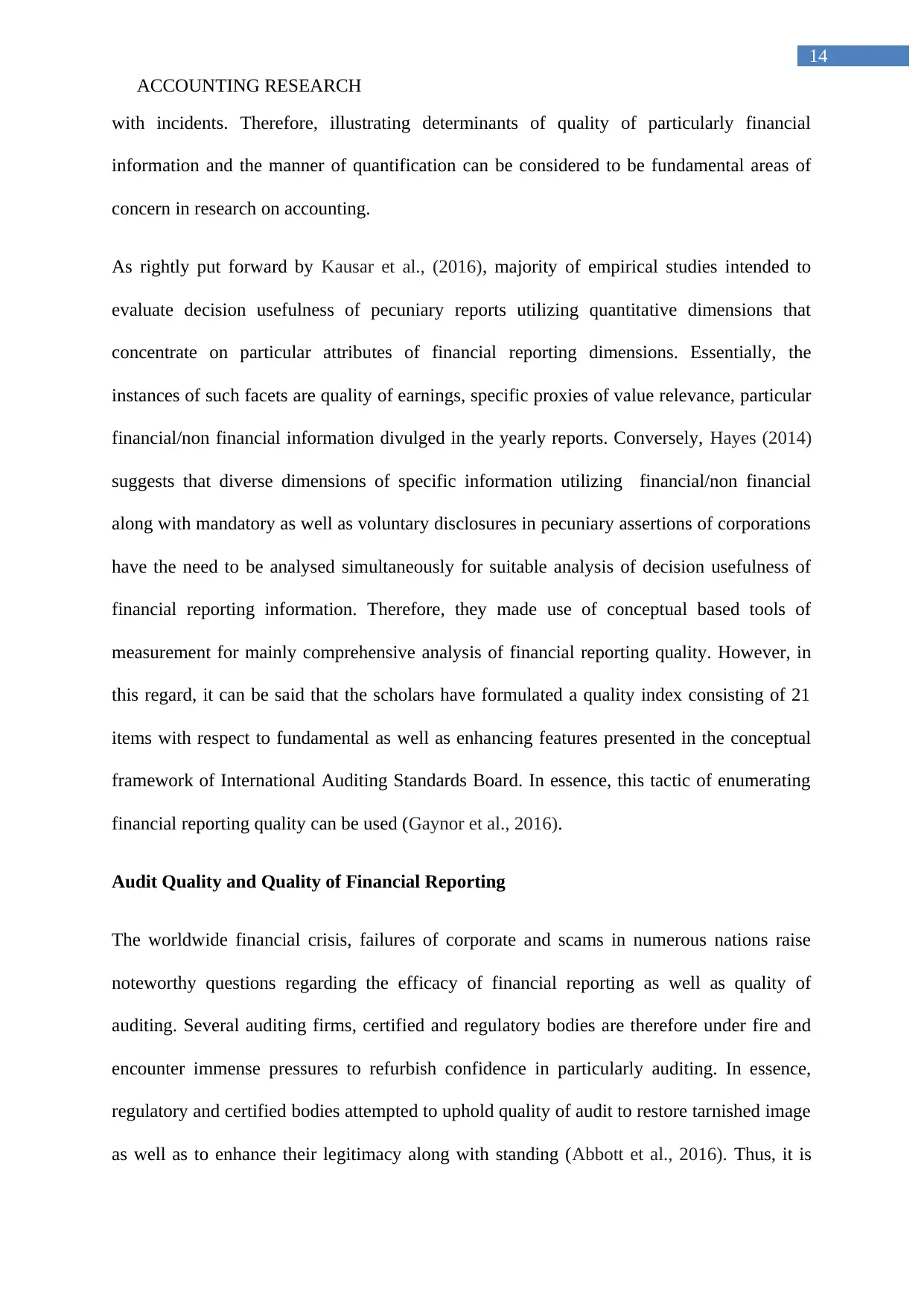
14
ACCOUNTING RESEARCH
with incidents. Therefore, illustrating determinants of quality of particularly financial
information and the manner of quantification can be considered to be fundamental areas of
concern in research on accounting.
As rightly put forward by Kausar et al., (2016), majority of empirical studies intended to
evaluate decision usefulness of pecuniary reports utilizing quantitative dimensions that
concentrate on particular attributes of financial reporting dimensions. Essentially, the
instances of such facets are quality of earnings, specific proxies of value relevance, particular
financial/non financial information divulged in the yearly reports. Conversely, Hayes (2014)
suggests that diverse dimensions of specific information utilizing financial/non financial
along with mandatory as well as voluntary disclosures in pecuniary assertions of corporations
have the need to be analysed simultaneously for suitable analysis of decision usefulness of
financial reporting information. Therefore, they made use of conceptual based tools of
measurement for mainly comprehensive analysis of financial reporting quality. However, in
this regard, it can be said that the scholars have formulated a quality index consisting of 21
items with respect to fundamental as well as enhancing features presented in the conceptual
framework of International Auditing Standards Board. In essence, this tactic of enumerating
financial reporting quality can be used (Gaynor et al., 2016).
Audit Quality and Quality of Financial Reporting
The worldwide financial crisis, failures of corporate and scams in numerous nations raise
noteworthy questions regarding the efficacy of financial reporting as well as quality of
auditing. Several auditing firms, certified and regulatory bodies are therefore under fire and
encounter immense pressures to refurbish confidence in particularly auditing. In essence,
regulatory and certified bodies attempted to uphold quality of audit to restore tarnished image
as well as to enhance their legitimacy along with standing (Abbott et al., 2016). Thus, it is
ACCOUNTING RESEARCH
with incidents. Therefore, illustrating determinants of quality of particularly financial
information and the manner of quantification can be considered to be fundamental areas of
concern in research on accounting.
As rightly put forward by Kausar et al., (2016), majority of empirical studies intended to
evaluate decision usefulness of pecuniary reports utilizing quantitative dimensions that
concentrate on particular attributes of financial reporting dimensions. Essentially, the
instances of such facets are quality of earnings, specific proxies of value relevance, particular
financial/non financial information divulged in the yearly reports. Conversely, Hayes (2014)
suggests that diverse dimensions of specific information utilizing financial/non financial
along with mandatory as well as voluntary disclosures in pecuniary assertions of corporations
have the need to be analysed simultaneously for suitable analysis of decision usefulness of
financial reporting information. Therefore, they made use of conceptual based tools of
measurement for mainly comprehensive analysis of financial reporting quality. However, in
this regard, it can be said that the scholars have formulated a quality index consisting of 21
items with respect to fundamental as well as enhancing features presented in the conceptual
framework of International Auditing Standards Board. In essence, this tactic of enumerating
financial reporting quality can be used (Gaynor et al., 2016).
Audit Quality and Quality of Financial Reporting
The worldwide financial crisis, failures of corporate and scams in numerous nations raise
noteworthy questions regarding the efficacy of financial reporting as well as quality of
auditing. Several auditing firms, certified and regulatory bodies are therefore under fire and
encounter immense pressures to refurbish confidence in particularly auditing. In essence,
regulatory and certified bodies attempted to uphold quality of audit to restore tarnished image
as well as to enhance their legitimacy along with standing (Abbott et al., 2016). Thus, it is

15
ACCOUNTING RESEARCH
anticipated that superior audit quality directs the way towards superior quality of financial
reporting that subsequently is a mechanism to avert financial crises. Abbott et al., (2010)
identify quality of financial reporting as particularly a precision with which different
pecuniary assertion conveys required information regarding operations of the firm,
specifically its anticipated flows of cash that let equity investors know about financial health
of the firm. Also, their characterization is consistent with directives laid down by Financial
Accounting Standards Board (FASB) that mentions that the main objective of financial
assertions is to notify present as well as potential financiers so that they can frame rational
decisions as regards investment and can evaluate the anticipated flows of cash of the
reporting entity (Aobdia et al., 2015).
Nevertheless, quality of audit is not openly observable; for that reason, it is quite complicated
to assess and quantify the same empirically. Yet, there are several proxies to enumerate
quality of audit. Fundamentally, accrual measure can be considered to be one of most
important proxies for ascertainment of quality of audit. Superior quality assessors are more
probable to identify irregularities in accounting, oppose to the employment of different
questionable practices of accounting, as well as restrain discretion specifically over accrual
choices for diverse client corporations (Badolato et al., 2014). As rightly indicated by Berger
et al., (2017), there are five different theoretical constructs that can be used to examine audit
quality. These five different constructs that can be used for assessment of quality of audit
include audit size, audit tenure (experience of auditor, that is to say, industry specialism),
and fees for audit, specific demographics, and category of local government. Bowlin et al.,
(2015) highlights that that there are two important characteristics of the financial reporting
arrangement are that an appraisal is particularly mandated for different publicly traded
corporations. Fundamentally, audit needs to be carried out by professional and expert
accountants who are necessarily independent in nature (that is to say, to have a specific
ACCOUNTING RESEARCH
anticipated that superior audit quality directs the way towards superior quality of financial
reporting that subsequently is a mechanism to avert financial crises. Abbott et al., (2010)
identify quality of financial reporting as particularly a precision with which different
pecuniary assertion conveys required information regarding operations of the firm,
specifically its anticipated flows of cash that let equity investors know about financial health
of the firm. Also, their characterization is consistent with directives laid down by Financial
Accounting Standards Board (FASB) that mentions that the main objective of financial
assertions is to notify present as well as potential financiers so that they can frame rational
decisions as regards investment and can evaluate the anticipated flows of cash of the
reporting entity (Aobdia et al., 2015).
Nevertheless, quality of audit is not openly observable; for that reason, it is quite complicated
to assess and quantify the same empirically. Yet, there are several proxies to enumerate
quality of audit. Fundamentally, accrual measure can be considered to be one of most
important proxies for ascertainment of quality of audit. Superior quality assessors are more
probable to identify irregularities in accounting, oppose to the employment of different
questionable practices of accounting, as well as restrain discretion specifically over accrual
choices for diverse client corporations (Badolato et al., 2014). As rightly indicated by Berger
et al., (2017), there are five different theoretical constructs that can be used to examine audit
quality. These five different constructs that can be used for assessment of quality of audit
include audit size, audit tenure (experience of auditor, that is to say, industry specialism),
and fees for audit, specific demographics, and category of local government. Bowlin et al.,
(2015) highlights that that there are two important characteristics of the financial reporting
arrangement are that an appraisal is particularly mandated for different publicly traded
corporations. Fundamentally, audit needs to be carried out by professional and expert
accountants who are necessarily independent in nature (that is to say, to have a specific
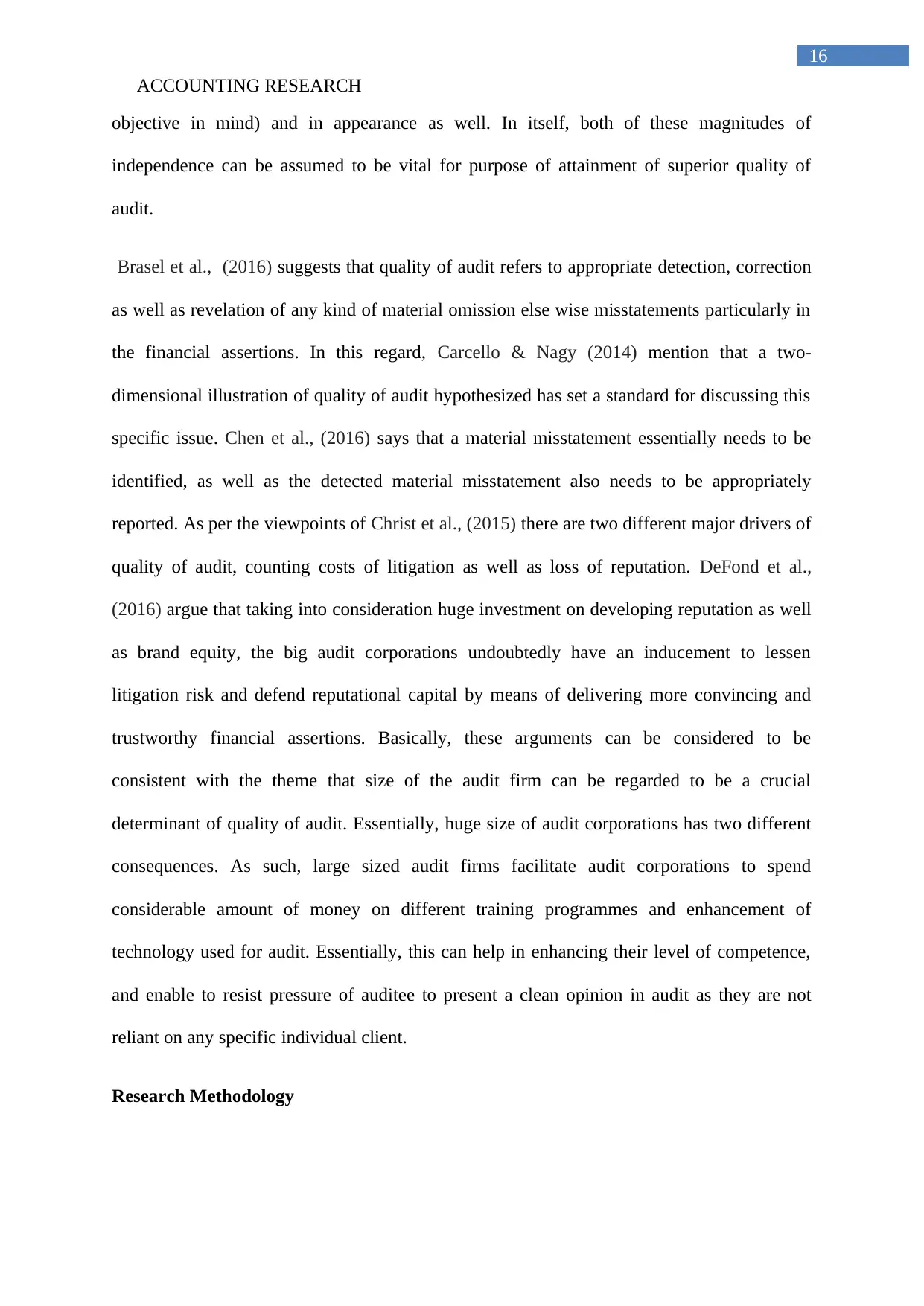
16
ACCOUNTING RESEARCH
objective in mind) and in appearance as well. In itself, both of these magnitudes of
independence can be assumed to be vital for purpose of attainment of superior quality of
audit.
Brasel et al., (2016) suggests that quality of audit refers to appropriate detection, correction
as well as revelation of any kind of material omission else wise misstatements particularly in
the financial assertions. In this regard, Carcello & Nagy (2014) mention that a two-
dimensional illustration of quality of audit hypothesized has set a standard for discussing this
specific issue. Chen et al., (2016) says that a material misstatement essentially needs to be
identified, as well as the detected material misstatement also needs to be appropriately
reported. As per the viewpoints of Christ et al., (2015) there are two different major drivers of
quality of audit, counting costs of litigation as well as loss of reputation. DeFond et al.,
(2016) argue that taking into consideration huge investment on developing reputation as well
as brand equity, the big audit corporations undoubtedly have an inducement to lessen
litigation risk and defend reputational capital by means of delivering more convincing and
trustworthy financial assertions. Basically, these arguments can be considered to be
consistent with the theme that size of the audit firm can be regarded to be a crucial
determinant of quality of audit. Essentially, huge size of audit corporations has two different
consequences. As such, large sized audit firms facilitate audit corporations to spend
considerable amount of money on different training programmes and enhancement of
technology used for audit. Essentially, this can help in enhancing their level of competence,
and enable to resist pressure of auditee to present a clean opinion in audit as they are not
reliant on any specific individual client.
Research Methodology
ACCOUNTING RESEARCH
objective in mind) and in appearance as well. In itself, both of these magnitudes of
independence can be assumed to be vital for purpose of attainment of superior quality of
audit.
Brasel et al., (2016) suggests that quality of audit refers to appropriate detection, correction
as well as revelation of any kind of material omission else wise misstatements particularly in
the financial assertions. In this regard, Carcello & Nagy (2014) mention that a two-
dimensional illustration of quality of audit hypothesized has set a standard for discussing this
specific issue. Chen et al., (2016) says that a material misstatement essentially needs to be
identified, as well as the detected material misstatement also needs to be appropriately
reported. As per the viewpoints of Christ et al., (2015) there are two different major drivers of
quality of audit, counting costs of litigation as well as loss of reputation. DeFond et al.,
(2016) argue that taking into consideration huge investment on developing reputation as well
as brand equity, the big audit corporations undoubtedly have an inducement to lessen
litigation risk and defend reputational capital by means of delivering more convincing and
trustworthy financial assertions. Basically, these arguments can be considered to be
consistent with the theme that size of the audit firm can be regarded to be a crucial
determinant of quality of audit. Essentially, huge size of audit corporations has two different
consequences. As such, large sized audit firms facilitate audit corporations to spend
considerable amount of money on different training programmes and enhancement of
technology used for audit. Essentially, this can help in enhancing their level of competence,
and enable to resist pressure of auditee to present a clean opinion in audit as they are not
reliant on any specific individual client.
Research Methodology
Secure Best Marks with AI Grader
Need help grading? Try our AI Grader for instant feedback on your assignments.
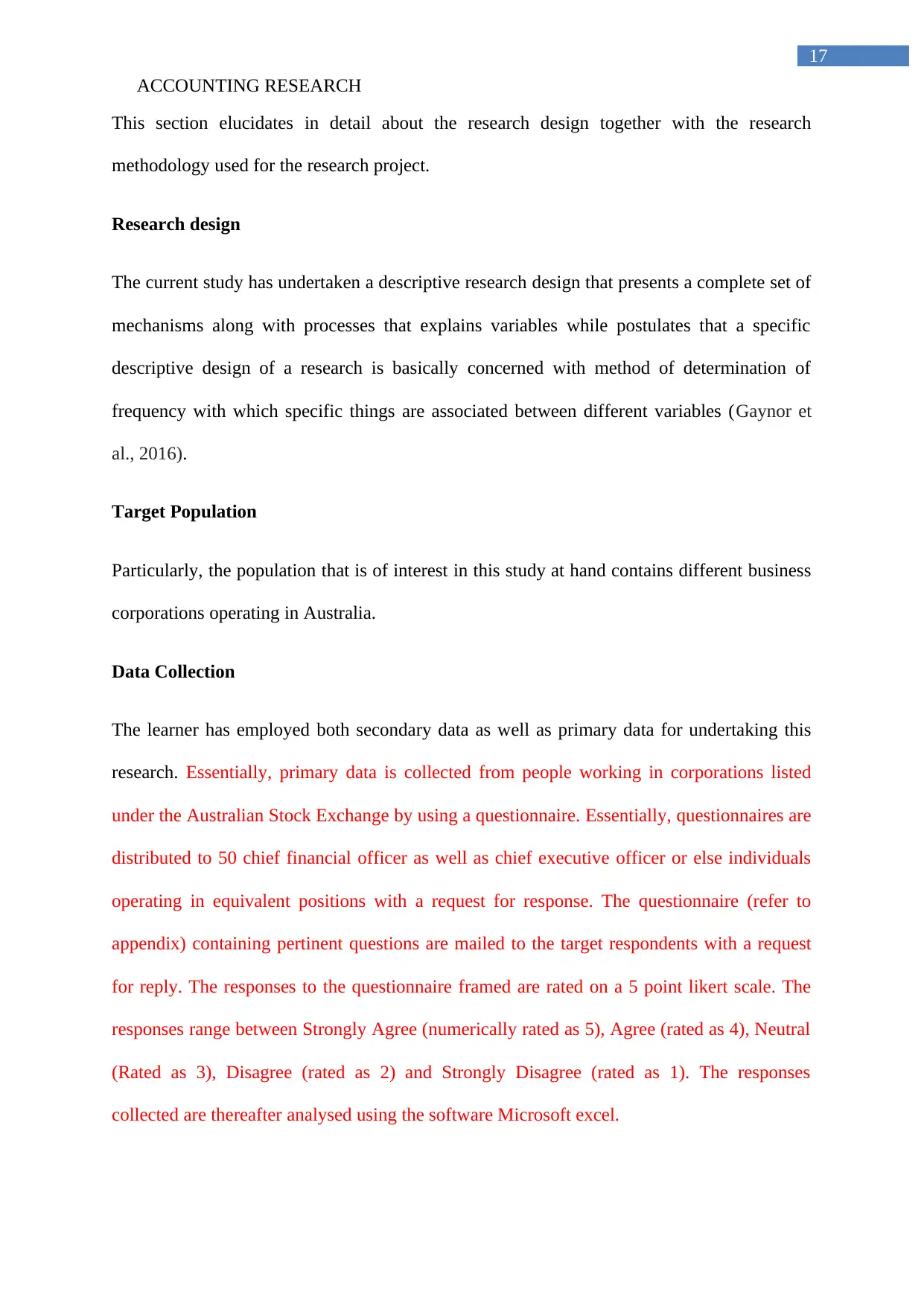
17
ACCOUNTING RESEARCH
This section elucidates in detail about the research design together with the research
methodology used for the research project.
Research design
The current study has undertaken a descriptive research design that presents a complete set of
mechanisms along with processes that explains variables while postulates that a specific
descriptive design of a research is basically concerned with method of determination of
frequency with which specific things are associated between different variables (Gaynor et
al., 2016).
Target Population
Particularly, the population that is of interest in this study at hand contains different business
corporations operating in Australia.
Data Collection
The learner has employed both secondary data as well as primary data for undertaking this
research. Essentially, primary data is collected from people working in corporations listed
under the Australian Stock Exchange by using a questionnaire. Essentially, questionnaires are
distributed to 50 chief financial officer as well as chief executive officer or else individuals
operating in equivalent positions with a request for response. The questionnaire (refer to
appendix) containing pertinent questions are mailed to the target respondents with a request
for reply. The responses to the questionnaire framed are rated on a 5 point likert scale. The
responses range between Strongly Agree (numerically rated as 5), Agree (rated as 4), Neutral
(Rated as 3), Disagree (rated as 2) and Strongly Disagree (rated as 1). The responses
collected are thereafter analysed using the software Microsoft excel.
ACCOUNTING RESEARCH
This section elucidates in detail about the research design together with the research
methodology used for the research project.
Research design
The current study has undertaken a descriptive research design that presents a complete set of
mechanisms along with processes that explains variables while postulates that a specific
descriptive design of a research is basically concerned with method of determination of
frequency with which specific things are associated between different variables (Gaynor et
al., 2016).
Target Population
Particularly, the population that is of interest in this study at hand contains different business
corporations operating in Australia.
Data Collection
The learner has employed both secondary data as well as primary data for undertaking this
research. Essentially, primary data is collected from people working in corporations listed
under the Australian Stock Exchange by using a questionnaire. Essentially, questionnaires are
distributed to 50 chief financial officer as well as chief executive officer or else individuals
operating in equivalent positions with a request for response. The questionnaire (refer to
appendix) containing pertinent questions are mailed to the target respondents with a request
for reply. The responses to the questionnaire framed are rated on a 5 point likert scale. The
responses range between Strongly Agree (numerically rated as 5), Agree (rated as 4), Neutral
(Rated as 3), Disagree (rated as 2) and Strongly Disagree (rated as 1). The responses
collected are thereafter analysed using the software Microsoft excel.
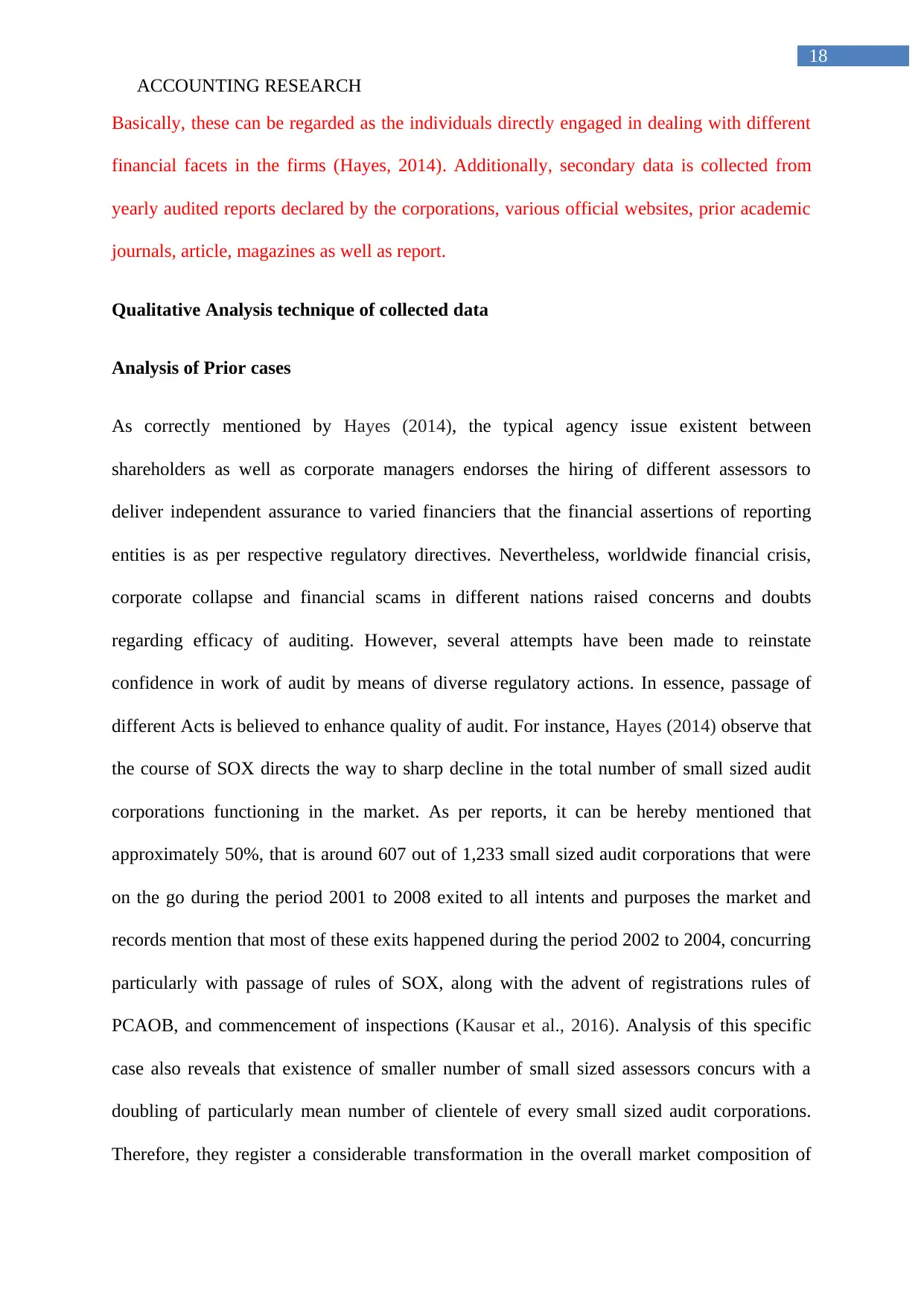
18
ACCOUNTING RESEARCH
Basically, these can be regarded as the individuals directly engaged in dealing with different
financial facets in the firms (Hayes, 2014). Additionally, secondary data is collected from
yearly audited reports declared by the corporations, various official websites, prior academic
journals, article, magazines as well as report.
Qualitative Analysis technique of collected data
Analysis of Prior cases
As correctly mentioned by Hayes (2014), the typical agency issue existent between
shareholders as well as corporate managers endorses the hiring of different assessors to
deliver independent assurance to varied financiers that the financial assertions of reporting
entities is as per respective regulatory directives. Nevertheless, worldwide financial crisis,
corporate collapse and financial scams in different nations raised concerns and doubts
regarding efficacy of auditing. However, several attempts have been made to reinstate
confidence in work of audit by means of diverse regulatory actions. In essence, passage of
different Acts is believed to enhance quality of audit. For instance, Hayes (2014) observe that
the course of SOX directs the way to sharp decline in the total number of small sized audit
corporations functioning in the market. As per reports, it can be hereby mentioned that
approximately 50%, that is around 607 out of 1,233 small sized audit corporations that were
on the go during the period 2001 to 2008 exited to all intents and purposes the market and
records mention that most of these exits happened during the period 2002 to 2004, concurring
particularly with passage of rules of SOX, along with the advent of registrations rules of
PCAOB, and commencement of inspections (Kausar et al., 2016). Analysis of this specific
case also reveals that existence of smaller number of small sized assessors concurs with a
doubling of particularly mean number of clientele of every small sized audit corporations.
Therefore, they register a considerable transformation in the overall market composition of
ACCOUNTING RESEARCH
Basically, these can be regarded as the individuals directly engaged in dealing with different
financial facets in the firms (Hayes, 2014). Additionally, secondary data is collected from
yearly audited reports declared by the corporations, various official websites, prior academic
journals, article, magazines as well as report.
Qualitative Analysis technique of collected data
Analysis of Prior cases
As correctly mentioned by Hayes (2014), the typical agency issue existent between
shareholders as well as corporate managers endorses the hiring of different assessors to
deliver independent assurance to varied financiers that the financial assertions of reporting
entities is as per respective regulatory directives. Nevertheless, worldwide financial crisis,
corporate collapse and financial scams in different nations raised concerns and doubts
regarding efficacy of auditing. However, several attempts have been made to reinstate
confidence in work of audit by means of diverse regulatory actions. In essence, passage of
different Acts is believed to enhance quality of audit. For instance, Hayes (2014) observe that
the course of SOX directs the way to sharp decline in the total number of small sized audit
corporations functioning in the market. As per reports, it can be hereby mentioned that
approximately 50%, that is around 607 out of 1,233 small sized audit corporations that were
on the go during the period 2001 to 2008 exited to all intents and purposes the market and
records mention that most of these exits happened during the period 2002 to 2004, concurring
particularly with passage of rules of SOX, along with the advent of registrations rules of
PCAOB, and commencement of inspections (Kausar et al., 2016). Analysis of this specific
case also reveals that existence of smaller number of small sized assessors concurs with a
doubling of particularly mean number of clientele of every small sized audit corporations.
Therefore, they register a considerable transformation in the overall market composition of

19
ACCOUNTING RESEARCH
small sized assessors after the process of adoption of particularly SOX. Further, they also
argue that inferior quality assessors are more probable to consider it to be more cost
beneficial, specifically at the margin, to walk out the market for mainly public corporation
audits for the fresh regulatory environment executed under SOX. Analysis of the present case
reflected the fact that the passage of specific Acts enhanced quality of audit in case if size of
audit was thought to be a specific proxy for quality of assessment. Furthermore, Kausar et al.,
(2016) mentions that it is anticipated that superior audit quality show the way to superior
quality of financial reporting. Nevertheless, the passage of Acts can be considered to be an
important factor that leads to enhancement of overall quality of preparation as well as
presentation of financial assertions.
As rightly put forward by Gaynor et al., (2016) perceptions regarding credit analysts as well
as financial analysts in connection with association between efficacy of audit committee,
auditing firm size and as well as quality can be considered by studying the same in context of
Bahrain. The case on Bahrain shows that results by survey of around 300 credit analysts as
well as financial analysts. This study throws light on four major findings. The case highlights
the finding that both credits with financial analysts perceive trustworthiness and reliability of
financial statements to be a function of the size of the auditing firm. The findings of the prior
study conducted reflect the fact that both the groups suppose that the features of Big-Four
accounting units permit them to deliver superior-quality assertions than varied non-Big
accounting corporations (Lennox et al., 2016). Also, findings of the study suggest that non-
audit services exert impact on independence of auditor and thereby impair quality of audit. In
addition to this, findings of prior research study also suggest that there are large groups of
analysts who are of the view that effectual audit committee can augment overall quality of
audit assertions. Furthermore, financial analysts also perceive pecuniary pronouncements to
be more plausible in comparison to different credit analysts. Lennox et al., (2016) state that
ACCOUNTING RESEARCH
small sized assessors after the process of adoption of particularly SOX. Further, they also
argue that inferior quality assessors are more probable to consider it to be more cost
beneficial, specifically at the margin, to walk out the market for mainly public corporation
audits for the fresh regulatory environment executed under SOX. Analysis of the present case
reflected the fact that the passage of specific Acts enhanced quality of audit in case if size of
audit was thought to be a specific proxy for quality of assessment. Furthermore, Kausar et al.,
(2016) mentions that it is anticipated that superior audit quality show the way to superior
quality of financial reporting. Nevertheless, the passage of Acts can be considered to be an
important factor that leads to enhancement of overall quality of preparation as well as
presentation of financial assertions.
As rightly put forward by Gaynor et al., (2016) perceptions regarding credit analysts as well
as financial analysts in connection with association between efficacy of audit committee,
auditing firm size and as well as quality can be considered by studying the same in context of
Bahrain. The case on Bahrain shows that results by survey of around 300 credit analysts as
well as financial analysts. This study throws light on four major findings. The case highlights
the finding that both credits with financial analysts perceive trustworthiness and reliability of
financial statements to be a function of the size of the auditing firm. The findings of the prior
study conducted reflect the fact that both the groups suppose that the features of Big-Four
accounting units permit them to deliver superior-quality assertions than varied non-Big
accounting corporations (Lennox et al., 2016). Also, findings of the study suggest that non-
audit services exert impact on independence of auditor and thereby impair quality of audit. In
addition to this, findings of prior research study also suggest that there are large groups of
analysts who are of the view that effectual audit committee can augment overall quality of
audit assertions. Furthermore, financial analysts also perceive pecuniary pronouncements to
be more plausible in comparison to different credit analysts. Lennox et al., (2016) state that
Paraphrase This Document
Need a fresh take? Get an instant paraphrase of this document with our AI Paraphraser
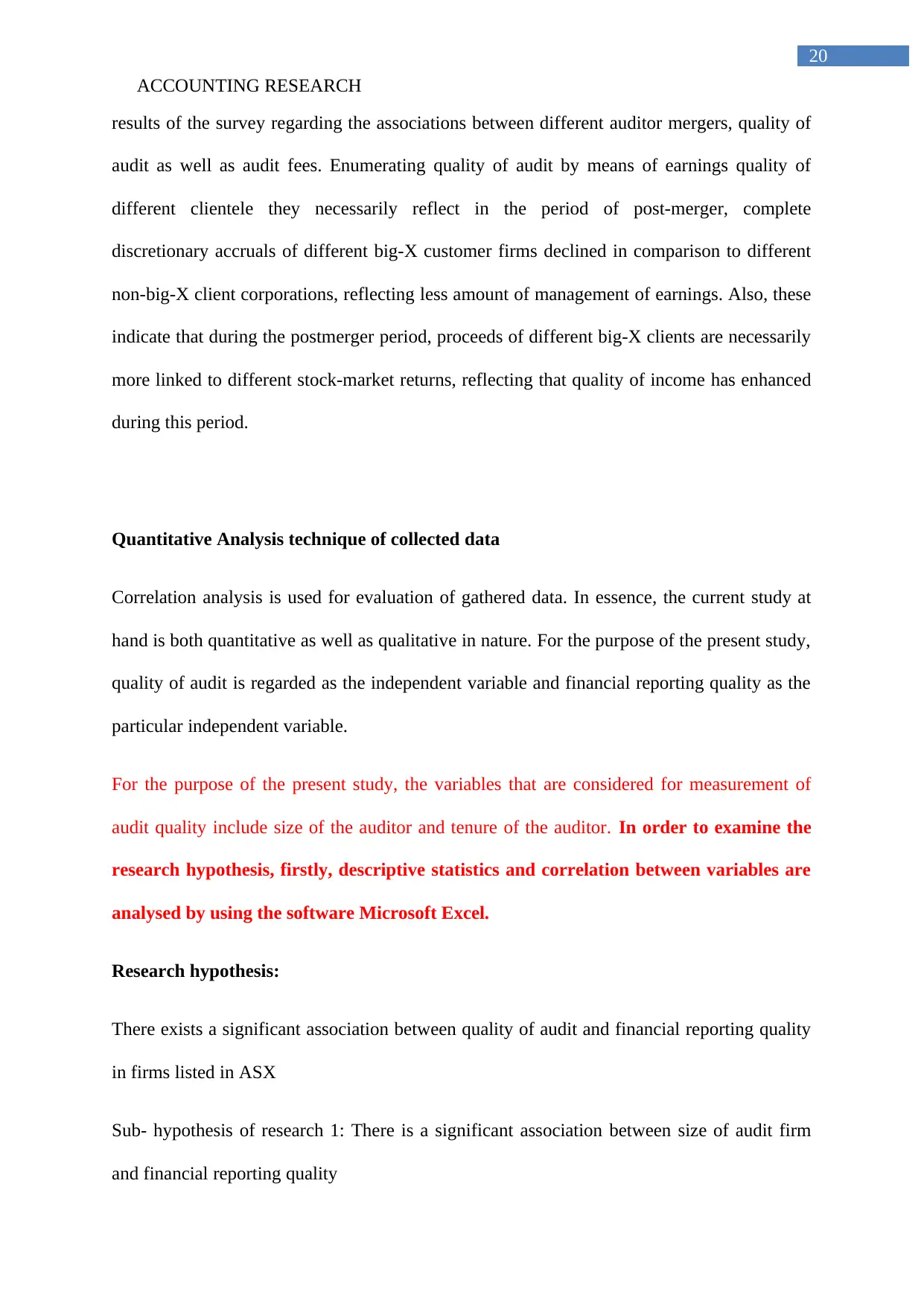
20
ACCOUNTING RESEARCH
results of the survey regarding the associations between different auditor mergers, quality of
audit as well as audit fees. Enumerating quality of audit by means of earnings quality of
different clientele they necessarily reflect in the period of post-merger, complete
discretionary accruals of different big-X customer firms declined in comparison to different
non-big-X client corporations, reflecting less amount of management of earnings. Also, these
indicate that during the postmerger period, proceeds of different big-X clients are necessarily
more linked to different stock-market returns, reflecting that quality of income has enhanced
during this period.
Quantitative Analysis technique of collected data
Correlation analysis is used for evaluation of gathered data. In essence, the current study at
hand is both quantitative as well as qualitative in nature. For the purpose of the present study,
quality of audit is regarded as the independent variable and financial reporting quality as the
particular independent variable.
For the purpose of the present study, the variables that are considered for measurement of
audit quality include size of the auditor and tenure of the auditor. In order to examine the
research hypothesis, firstly, descriptive statistics and correlation between variables are
analysed by using the software Microsoft Excel.
Research hypothesis:
There exists a significant association between quality of audit and financial reporting quality
in firms listed in ASX
Sub- hypothesis of research 1: There is a significant association between size of audit firm
and financial reporting quality
ACCOUNTING RESEARCH
results of the survey regarding the associations between different auditor mergers, quality of
audit as well as audit fees. Enumerating quality of audit by means of earnings quality of
different clientele they necessarily reflect in the period of post-merger, complete
discretionary accruals of different big-X customer firms declined in comparison to different
non-big-X client corporations, reflecting less amount of management of earnings. Also, these
indicate that during the postmerger period, proceeds of different big-X clients are necessarily
more linked to different stock-market returns, reflecting that quality of income has enhanced
during this period.
Quantitative Analysis technique of collected data
Correlation analysis is used for evaluation of gathered data. In essence, the current study at
hand is both quantitative as well as qualitative in nature. For the purpose of the present study,
quality of audit is regarded as the independent variable and financial reporting quality as the
particular independent variable.
For the purpose of the present study, the variables that are considered for measurement of
audit quality include size of the auditor and tenure of the auditor. In order to examine the
research hypothesis, firstly, descriptive statistics and correlation between variables are
analysed by using the software Microsoft Excel.
Research hypothesis:
There exists a significant association between quality of audit and financial reporting quality
in firms listed in ASX
Sub- hypothesis of research 1: There is a significant association between size of audit firm
and financial reporting quality
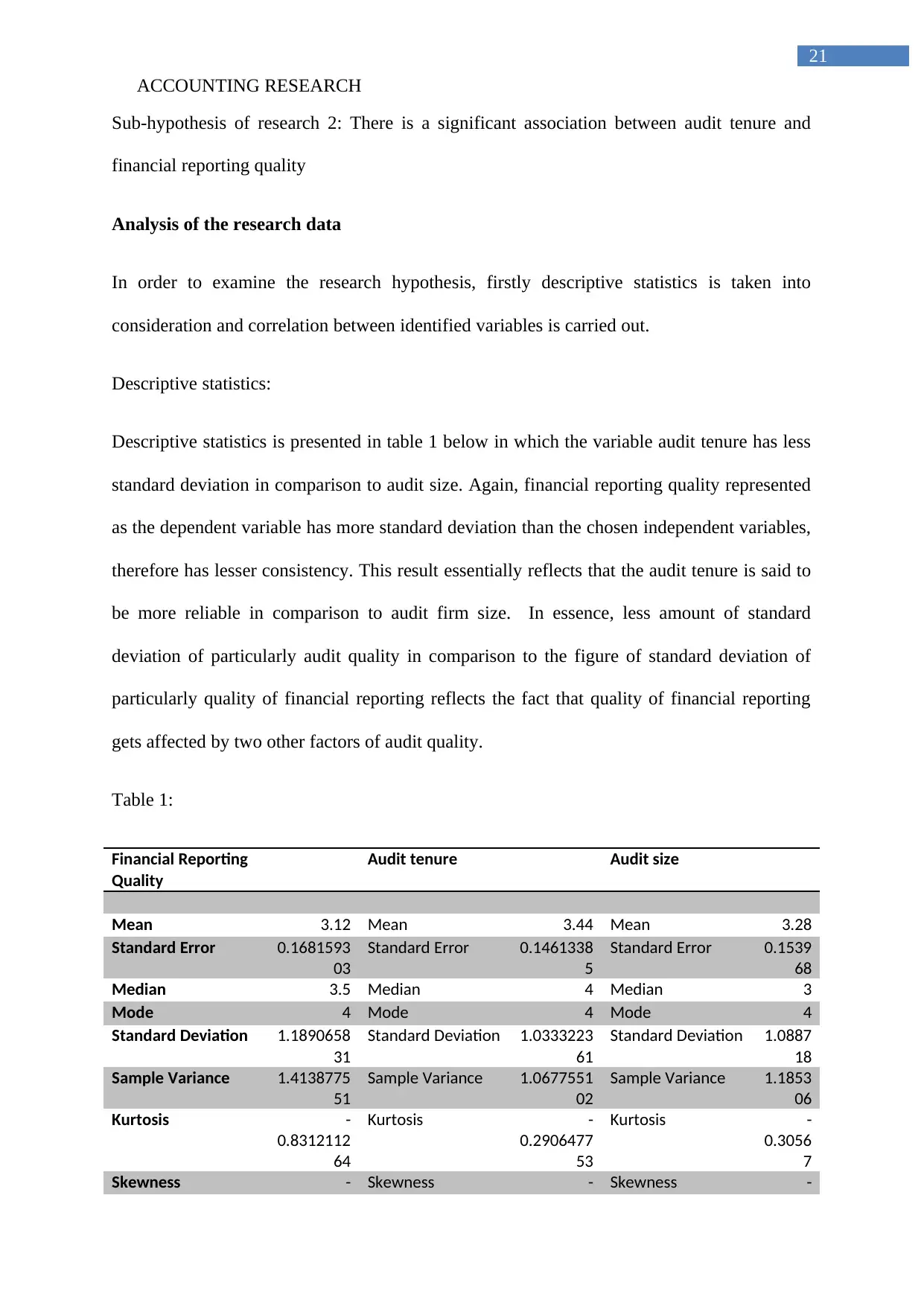
21
ACCOUNTING RESEARCH
Sub-hypothesis of research 2: There is a significant association between audit tenure and
financial reporting quality
Analysis of the research data
In order to examine the research hypothesis, firstly descriptive statistics is taken into
consideration and correlation between identified variables is carried out.
Descriptive statistics:
Descriptive statistics is presented in table 1 below in which the variable audit tenure has less
standard deviation in comparison to audit size. Again, financial reporting quality represented
as the dependent variable has more standard deviation than the chosen independent variables,
therefore has lesser consistency. This result essentially reflects that the audit tenure is said to
be more reliable in comparison to audit firm size. In essence, less amount of standard
deviation of particularly audit quality in comparison to the figure of standard deviation of
particularly quality of financial reporting reflects the fact that quality of financial reporting
gets affected by two other factors of audit quality.
Table 1:
Financial Reporting
Quality
Audit tenure Audit size
Mean 3.12 Mean 3.44 Mean 3.28
Standard Error 0.1681593
03
Standard Error 0.1461338
5
Standard Error 0.1539
68
Median 3.5 Median 4 Median 3
Mode 4 Mode 4 Mode 4
Standard Deviation 1.1890658
31
Standard Deviation 1.0333223
61
Standard Deviation 1.0887
18
Sample Variance 1.4138775
51
Sample Variance 1.0677551
02
Sample Variance 1.1853
06
Kurtosis -
0.8312112
64
Kurtosis -
0.2906477
53
Kurtosis -
0.3056
7
Skewness - Skewness - Skewness -
ACCOUNTING RESEARCH
Sub-hypothesis of research 2: There is a significant association between audit tenure and
financial reporting quality
Analysis of the research data
In order to examine the research hypothesis, firstly descriptive statistics is taken into
consideration and correlation between identified variables is carried out.
Descriptive statistics:
Descriptive statistics is presented in table 1 below in which the variable audit tenure has less
standard deviation in comparison to audit size. Again, financial reporting quality represented
as the dependent variable has more standard deviation than the chosen independent variables,
therefore has lesser consistency. This result essentially reflects that the audit tenure is said to
be more reliable in comparison to audit firm size. In essence, less amount of standard
deviation of particularly audit quality in comparison to the figure of standard deviation of
particularly quality of financial reporting reflects the fact that quality of financial reporting
gets affected by two other factors of audit quality.
Table 1:
Financial Reporting
Quality
Audit tenure Audit size
Mean 3.12 Mean 3.44 Mean 3.28
Standard Error 0.1681593
03
Standard Error 0.1461338
5
Standard Error 0.1539
68
Median 3.5 Median 4 Median 3
Mode 4 Mode 4 Mode 4
Standard Deviation 1.1890658
31
Standard Deviation 1.0333223
61
Standard Deviation 1.0887
18
Sample Variance 1.4138775
51
Sample Variance 1.0677551
02
Sample Variance 1.1853
06
Kurtosis -
0.8312112
64
Kurtosis -
0.2906477
53
Kurtosis -
0.3056
7
Skewness - Skewness - Skewness -
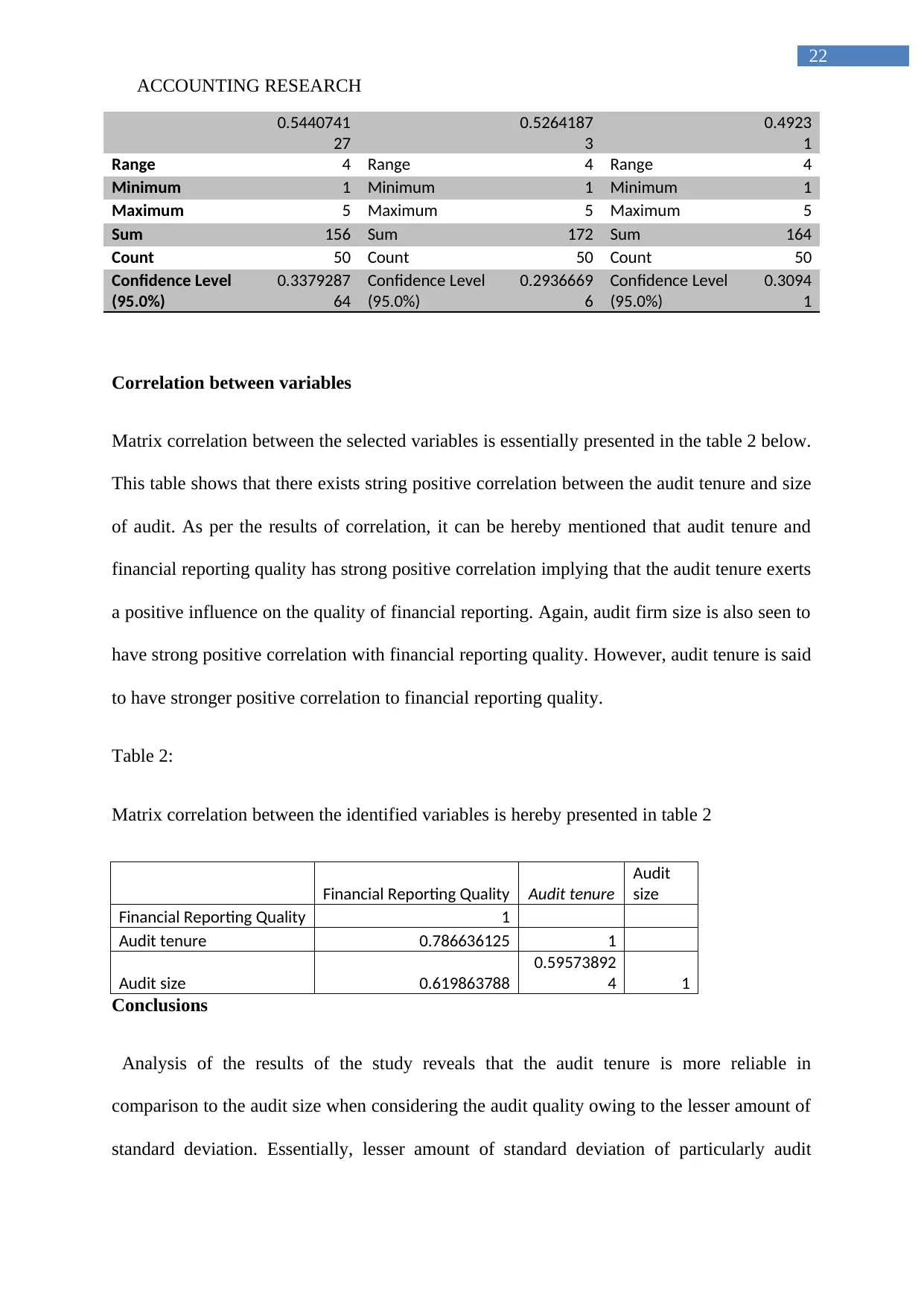
22
ACCOUNTING RESEARCH
0.5440741
27
0.5264187
3
0.4923
1
Range 4 Range 4 Range 4
Minimum 1 Minimum 1 Minimum 1
Maximum 5 Maximum 5 Maximum 5
Sum 156 Sum 172 Sum 164
Count 50 Count 50 Count 50
Confidence Level
(95.0%)
0.3379287
64
Confidence Level
(95.0%)
0.2936669
6
Confidence Level
(95.0%)
0.3094
1
Correlation between variables
Matrix correlation between the selected variables is essentially presented in the table 2 below.
This table shows that there exists string positive correlation between the audit tenure and size
of audit. As per the results of correlation, it can be hereby mentioned that audit tenure and
financial reporting quality has strong positive correlation implying that the audit tenure exerts
a positive influence on the quality of financial reporting. Again, audit firm size is also seen to
have strong positive correlation with financial reporting quality. However, audit tenure is said
to have stronger positive correlation to financial reporting quality.
Table 2:
Matrix correlation between the identified variables is hereby presented in table 2
Financial Reporting Quality Audit tenure
Audit
size
Financial Reporting Quality 1
Audit tenure 0.786636125 1
Audit size 0.619863788
0.59573892
4 1
Conclusions
Analysis of the results of the study reveals that the audit tenure is more reliable in
comparison to the audit size when considering the audit quality owing to the lesser amount of
standard deviation. Essentially, lesser amount of standard deviation of particularly audit
ACCOUNTING RESEARCH
0.5440741
27
0.5264187
3
0.4923
1
Range 4 Range 4 Range 4
Minimum 1 Minimum 1 Minimum 1
Maximum 5 Maximum 5 Maximum 5
Sum 156 Sum 172 Sum 164
Count 50 Count 50 Count 50
Confidence Level
(95.0%)
0.3379287
64
Confidence Level
(95.0%)
0.2936669
6
Confidence Level
(95.0%)
0.3094
1
Correlation between variables
Matrix correlation between the selected variables is essentially presented in the table 2 below.
This table shows that there exists string positive correlation between the audit tenure and size
of audit. As per the results of correlation, it can be hereby mentioned that audit tenure and
financial reporting quality has strong positive correlation implying that the audit tenure exerts
a positive influence on the quality of financial reporting. Again, audit firm size is also seen to
have strong positive correlation with financial reporting quality. However, audit tenure is said
to have stronger positive correlation to financial reporting quality.
Table 2:
Matrix correlation between the identified variables is hereby presented in table 2
Financial Reporting Quality Audit tenure
Audit
size
Financial Reporting Quality 1
Audit tenure 0.786636125 1
Audit size 0.619863788
0.59573892
4 1
Conclusions
Analysis of the results of the study reveals that the audit tenure is more reliable in
comparison to the audit size when considering the audit quality owing to the lesser amount of
standard deviation. Essentially, lesser amount of standard deviation of particularly audit
Secure Best Marks with AI Grader
Need help grading? Try our AI Grader for instant feedback on your assignments.
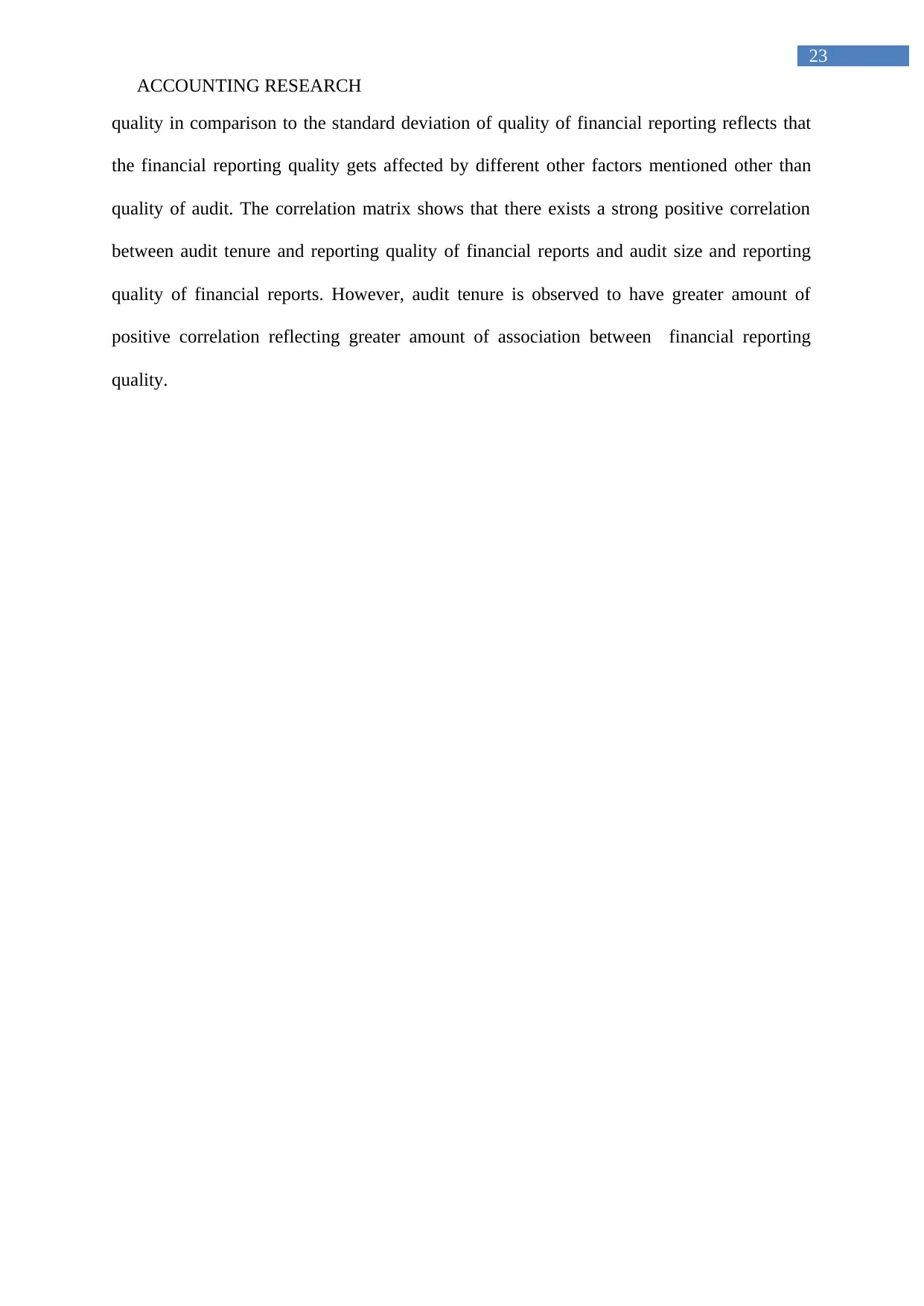
23
ACCOUNTING RESEARCH
quality in comparison to the standard deviation of quality of financial reporting reflects that
the financial reporting quality gets affected by different other factors mentioned other than
quality of audit. The correlation matrix shows that there exists a strong positive correlation
between audit tenure and reporting quality of financial reports and audit size and reporting
quality of financial reports. However, audit tenure is observed to have greater amount of
positive correlation reflecting greater amount of association between financial reporting
quality.
ACCOUNTING RESEARCH
quality in comparison to the standard deviation of quality of financial reporting reflects that
the financial reporting quality gets affected by different other factors mentioned other than
quality of audit. The correlation matrix shows that there exists a strong positive correlation
between audit tenure and reporting quality of financial reports and audit size and reporting
quality of financial reports. However, audit tenure is observed to have greater amount of
positive correlation reflecting greater amount of association between financial reporting
quality.
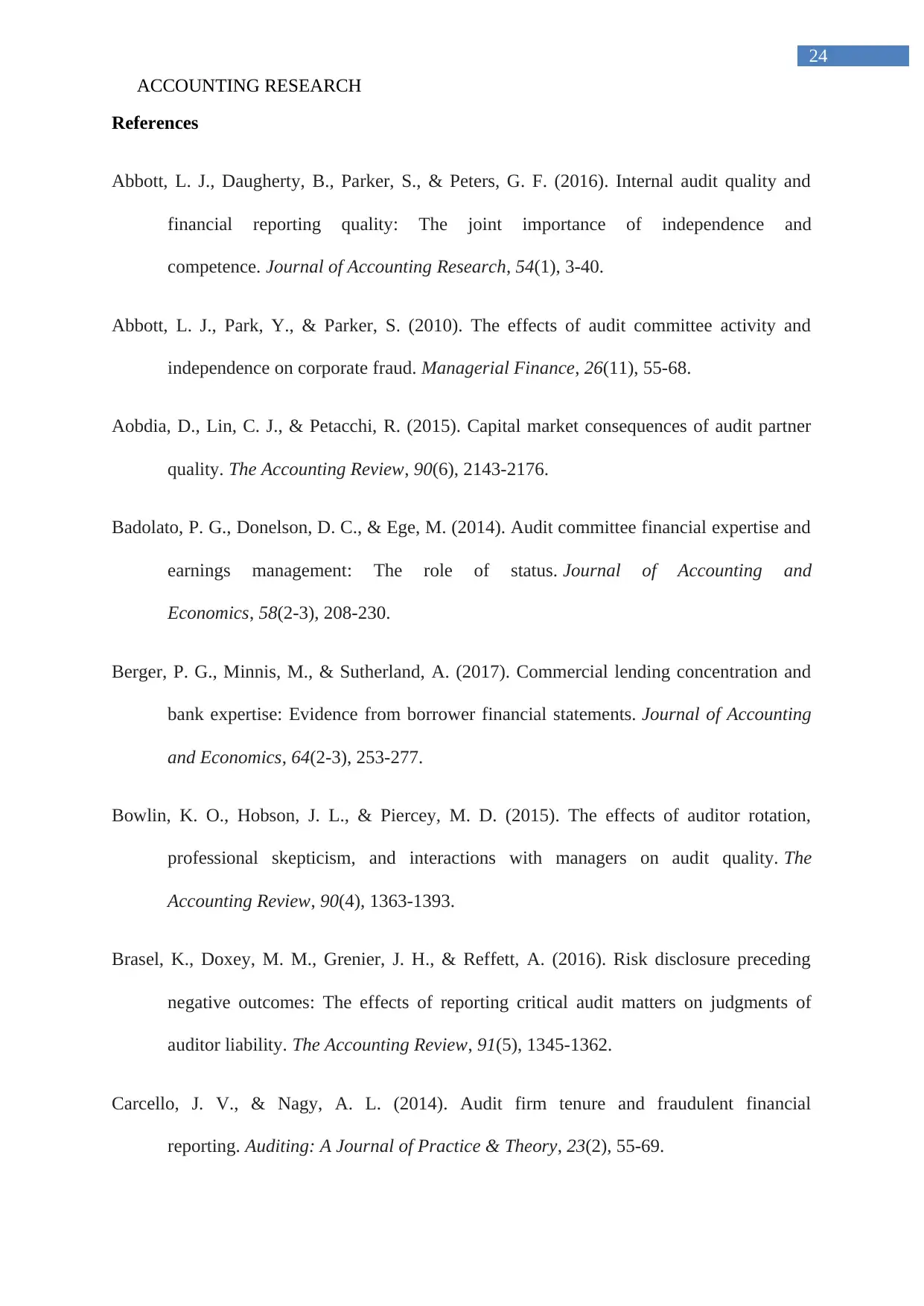
24
ACCOUNTING RESEARCH
References
Abbott, L. J., Daugherty, B., Parker, S., & Peters, G. F. (2016). Internal audit quality and
financial reporting quality: The joint importance of independence and
competence. Journal of Accounting Research, 54(1), 3-40.
Abbott, L. J., Park, Y., & Parker, S. (2010). The effects of audit committee activity and
independence on corporate fraud. Managerial Finance, 26(11), 55-68.
Aobdia, D., Lin, C. J., & Petacchi, R. (2015). Capital market consequences of audit partner
quality. The Accounting Review, 90(6), 2143-2176.
Badolato, P. G., Donelson, D. C., & Ege, M. (2014). Audit committee financial expertise and
earnings management: The role of status. Journal of Accounting and
Economics, 58(2-3), 208-230.
Berger, P. G., Minnis, M., & Sutherland, A. (2017). Commercial lending concentration and
bank expertise: Evidence from borrower financial statements. Journal of Accounting
and Economics, 64(2-3), 253-277.
Bowlin, K. O., Hobson, J. L., & Piercey, M. D. (2015). The effects of auditor rotation,
professional skepticism, and interactions with managers on audit quality. The
Accounting Review, 90(4), 1363-1393.
Brasel, K., Doxey, M. M., Grenier, J. H., & Reffett, A. (2016). Risk disclosure preceding
negative outcomes: The effects of reporting critical audit matters on judgments of
auditor liability. The Accounting Review, 91(5), 1345-1362.
Carcello, J. V., & Nagy, A. L. (2014). Audit firm tenure and fraudulent financial
reporting. Auditing: A Journal of Practice & Theory, 23(2), 55-69.
ACCOUNTING RESEARCH
References
Abbott, L. J., Daugherty, B., Parker, S., & Peters, G. F. (2016). Internal audit quality and
financial reporting quality: The joint importance of independence and
competence. Journal of Accounting Research, 54(1), 3-40.
Abbott, L. J., Park, Y., & Parker, S. (2010). The effects of audit committee activity and
independence on corporate fraud. Managerial Finance, 26(11), 55-68.
Aobdia, D., Lin, C. J., & Petacchi, R. (2015). Capital market consequences of audit partner
quality. The Accounting Review, 90(6), 2143-2176.
Badolato, P. G., Donelson, D. C., & Ege, M. (2014). Audit committee financial expertise and
earnings management: The role of status. Journal of Accounting and
Economics, 58(2-3), 208-230.
Berger, P. G., Minnis, M., & Sutherland, A. (2017). Commercial lending concentration and
bank expertise: Evidence from borrower financial statements. Journal of Accounting
and Economics, 64(2-3), 253-277.
Bowlin, K. O., Hobson, J. L., & Piercey, M. D. (2015). The effects of auditor rotation,
professional skepticism, and interactions with managers on audit quality. The
Accounting Review, 90(4), 1363-1393.
Brasel, K., Doxey, M. M., Grenier, J. H., & Reffett, A. (2016). Risk disclosure preceding
negative outcomes: The effects of reporting critical audit matters on judgments of
auditor liability. The Accounting Review, 91(5), 1345-1362.
Carcello, J. V., & Nagy, A. L. (2014). Audit firm tenure and fraudulent financial
reporting. Auditing: A Journal of Practice & Theory, 23(2), 55-69.
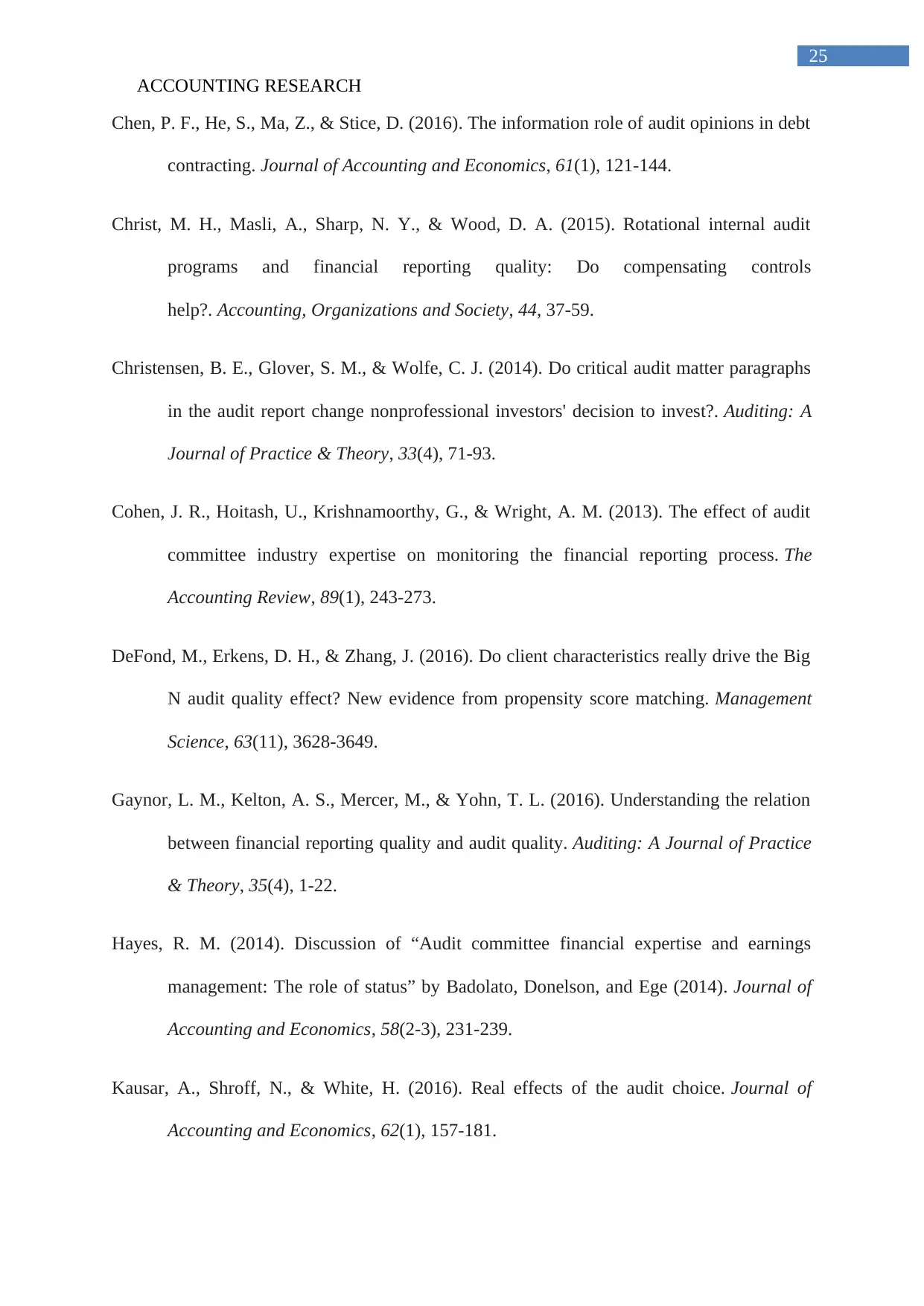
25
ACCOUNTING RESEARCH
Chen, P. F., He, S., Ma, Z., & Stice, D. (2016). The information role of audit opinions in debt
contracting. Journal of Accounting and Economics, 61(1), 121-144.
Christ, M. H., Masli, A., Sharp, N. Y., & Wood, D. A. (2015). Rotational internal audit
programs and financial reporting quality: Do compensating controls
help?. Accounting, Organizations and Society, 44, 37-59.
Christensen, B. E., Glover, S. M., & Wolfe, C. J. (2014). Do critical audit matter paragraphs
in the audit report change nonprofessional investors' decision to invest?. Auditing: A
Journal of Practice & Theory, 33(4), 71-93.
Cohen, J. R., Hoitash, U., Krishnamoorthy, G., & Wright, A. M. (2013). The effect of audit
committee industry expertise on monitoring the financial reporting process. The
Accounting Review, 89(1), 243-273.
DeFond, M., Erkens, D. H., & Zhang, J. (2016). Do client characteristics really drive the Big
N audit quality effect? New evidence from propensity score matching. Management
Science, 63(11), 3628-3649.
Gaynor, L. M., Kelton, A. S., Mercer, M., & Yohn, T. L. (2016). Understanding the relation
between financial reporting quality and audit quality. Auditing: A Journal of Practice
& Theory, 35(4), 1-22.
Hayes, R. M. (2014). Discussion of “Audit committee financial expertise and earnings
management: The role of status” by Badolato, Donelson, and Ege (2014). Journal of
Accounting and Economics, 58(2-3), 231-239.
Kausar, A., Shroff, N., & White, H. (2016). Real effects of the audit choice. Journal of
Accounting and Economics, 62(1), 157-181.
ACCOUNTING RESEARCH
Chen, P. F., He, S., Ma, Z., & Stice, D. (2016). The information role of audit opinions in debt
contracting. Journal of Accounting and Economics, 61(1), 121-144.
Christ, M. H., Masli, A., Sharp, N. Y., & Wood, D. A. (2015). Rotational internal audit
programs and financial reporting quality: Do compensating controls
help?. Accounting, Organizations and Society, 44, 37-59.
Christensen, B. E., Glover, S. M., & Wolfe, C. J. (2014). Do critical audit matter paragraphs
in the audit report change nonprofessional investors' decision to invest?. Auditing: A
Journal of Practice & Theory, 33(4), 71-93.
Cohen, J. R., Hoitash, U., Krishnamoorthy, G., & Wright, A. M. (2013). The effect of audit
committee industry expertise on monitoring the financial reporting process. The
Accounting Review, 89(1), 243-273.
DeFond, M., Erkens, D. H., & Zhang, J. (2016). Do client characteristics really drive the Big
N audit quality effect? New evidence from propensity score matching. Management
Science, 63(11), 3628-3649.
Gaynor, L. M., Kelton, A. S., Mercer, M., & Yohn, T. L. (2016). Understanding the relation
between financial reporting quality and audit quality. Auditing: A Journal of Practice
& Theory, 35(4), 1-22.
Hayes, R. M. (2014). Discussion of “Audit committee financial expertise and earnings
management: The role of status” by Badolato, Donelson, and Ege (2014). Journal of
Accounting and Economics, 58(2-3), 231-239.
Kausar, A., Shroff, N., & White, H. (2016). Real effects of the audit choice. Journal of
Accounting and Economics, 62(1), 157-181.
Paraphrase This Document
Need a fresh take? Get an instant paraphrase of this document with our AI Paraphraser

26
ACCOUNTING RESEARCH
Krishnan, J., Krishnan, J., & Song, H. (2016). PCAOB international inspections and audit
quality. The Accounting Review, 92(5), 143-166.
Lennox, C., Wu, X., & Zhang, T. (2016). The effect of audit adjustments on earnings quality:
Evidence from China. Journal of Accounting and Economics, 61(2-3), 545-562.
Lisowsky, P., Minnis, M., & Sutherland, A. (2017). Economic growth and financial statement
verification. Journal of Accounting Research, 55(4), 745-794.
Pucheta‐Martínez, M. C., & García‐Meca, E. (2014). Institutional investors on boards and
audit committees and their effects on financial reporting quality. Corporate
Governance: An International Review, 22(4), 347-363.
Rezaee, Z., Sharbatoghlie, A., Elam, R., & McMickle, P. L. (2018). Continuous auditing:
Building automated auditing capability. In Continuous Auditing: Theory and
Application (pp. 169-190). Emerald Publishing Limited.
Robert Knechel, W., Vanstraelen, A., & Zerni, M. (2015). Does the identity of engagement
partners matter? An analysis of audit partner reporting decisions. Contemporary
Accounting Research, 32(4), 1443-1478.
Robert Knechel, W., Vanstraelen, A., & Zerni, M. (2015). Does the identity of engagement
partners matter? An analysis of audit partner reporting decisions. Contemporary
Accounting Research, 32(4), 1443-1478.
Sirois, L. P., Bédard, J., & Bera, P. (2018). The informational value of key audit matters in
the auditor's report: Evidence from an eye-tracking study. Accounting Horizons.
ACCOUNTING RESEARCH
Krishnan, J., Krishnan, J., & Song, H. (2016). PCAOB international inspections and audit
quality. The Accounting Review, 92(5), 143-166.
Lennox, C., Wu, X., & Zhang, T. (2016). The effect of audit adjustments on earnings quality:
Evidence from China. Journal of Accounting and Economics, 61(2-3), 545-562.
Lisowsky, P., Minnis, M., & Sutherland, A. (2017). Economic growth and financial statement
verification. Journal of Accounting Research, 55(4), 745-794.
Pucheta‐Martínez, M. C., & García‐Meca, E. (2014). Institutional investors on boards and
audit committees and their effects on financial reporting quality. Corporate
Governance: An International Review, 22(4), 347-363.
Rezaee, Z., Sharbatoghlie, A., Elam, R., & McMickle, P. L. (2018). Continuous auditing:
Building automated auditing capability. In Continuous Auditing: Theory and
Application (pp. 169-190). Emerald Publishing Limited.
Robert Knechel, W., Vanstraelen, A., & Zerni, M. (2015). Does the identity of engagement
partners matter? An analysis of audit partner reporting decisions. Contemporary
Accounting Research, 32(4), 1443-1478.
Robert Knechel, W., Vanstraelen, A., & Zerni, M. (2015). Does the identity of engagement
partners matter? An analysis of audit partner reporting decisions. Contemporary
Accounting Research, 32(4), 1443-1478.
Sirois, L. P., Bédard, J., & Bera, P. (2018). The informational value of key audit matters in
the auditor's report: Evidence from an eye-tracking study. Accounting Horizons.
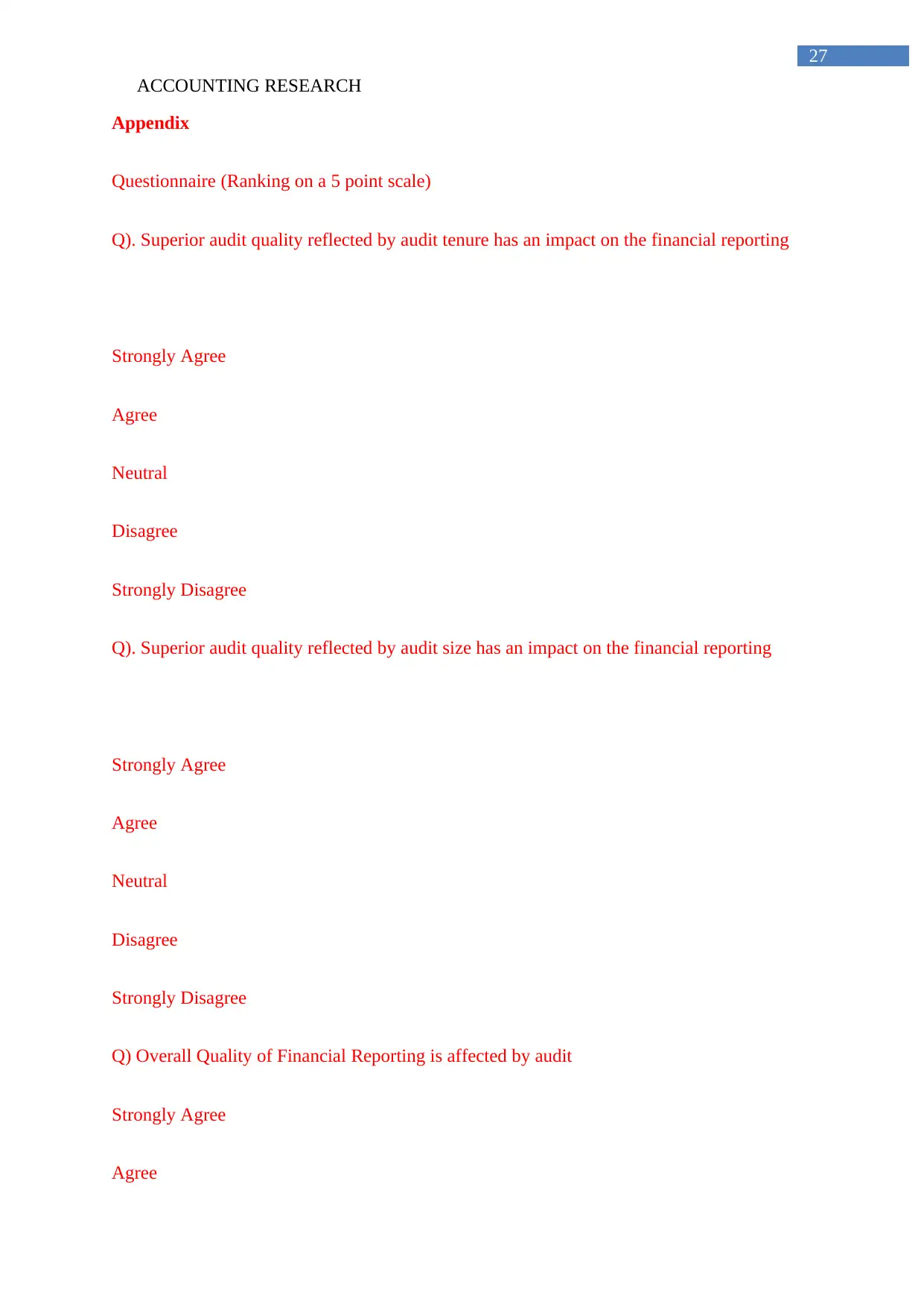
27
ACCOUNTING RESEARCH
Appendix
Questionnaire (Ranking on a 5 point scale)
Q). Superior audit quality reflected by audit tenure has an impact on the financial reporting
Strongly Agree
Agree
Neutral
Disagree
Strongly Disagree
Q). Superior audit quality reflected by audit size has an impact on the financial reporting
Strongly Agree
Agree
Neutral
Disagree
Strongly Disagree
Q) Overall Quality of Financial Reporting is affected by audit
Strongly Agree
Agree
ACCOUNTING RESEARCH
Appendix
Questionnaire (Ranking on a 5 point scale)
Q). Superior audit quality reflected by audit tenure has an impact on the financial reporting
Strongly Agree
Agree
Neutral
Disagree
Strongly Disagree
Q). Superior audit quality reflected by audit size has an impact on the financial reporting
Strongly Agree
Agree
Neutral
Disagree
Strongly Disagree
Q) Overall Quality of Financial Reporting is affected by audit
Strongly Agree
Agree
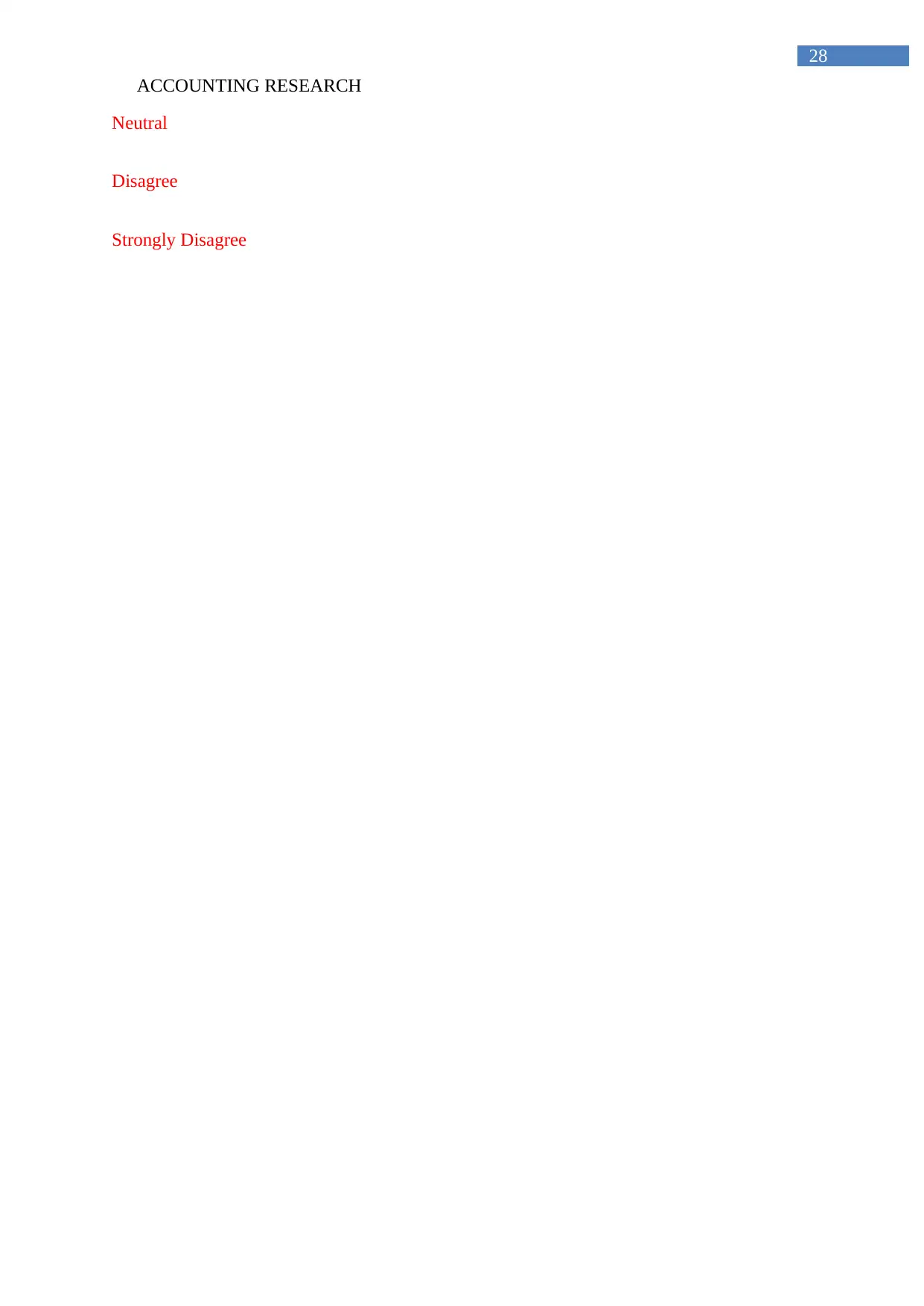
28
ACCOUNTING RESEARCH
Neutral
Disagree
Strongly Disagree
ACCOUNTING RESEARCH
Neutral
Disagree
Strongly Disagree
1 out of 28
Related Documents
Your All-in-One AI-Powered Toolkit for Academic Success.
+13062052269
info@desklib.com
Available 24*7 on WhatsApp / Email
![[object Object]](/_next/static/media/star-bottom.7253800d.svg)
Unlock your academic potential
© 2024 | Zucol Services PVT LTD | All rights reserved.




